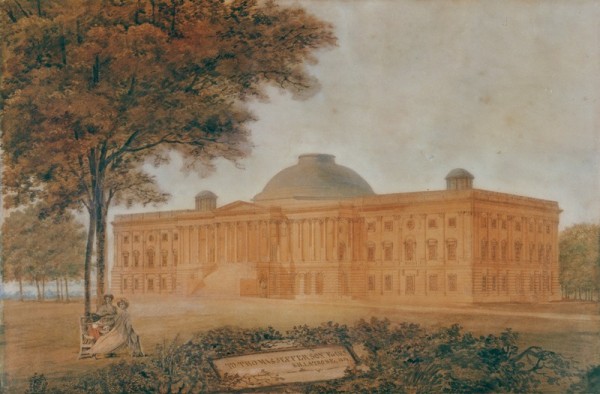
Benjamin Henry Latrobe, United States Capitol, Washington, D.C. Perspective from the Northeast, 1806. Watercolor and ink on paper. 19 1/4" x 23 1/4". (Courtesy, Library of Congress.) The inscription reads: “TO THOMAS JEFFERSON Pres. U.S., B.H. LATROBE, 1806.”
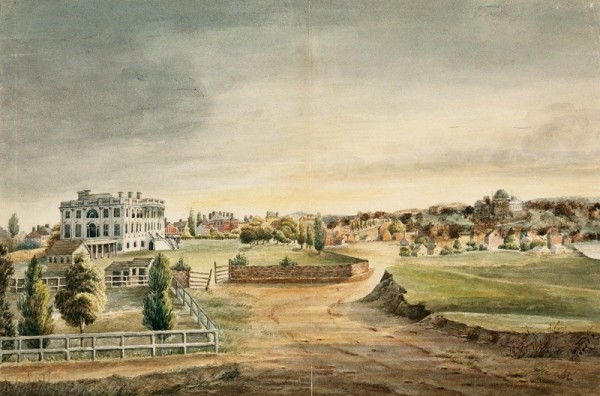
Anthony St. John Baker, The White House and Capitol, ca. 1827. Watercolor on paper. 7 5/8" x 11 5/8". (Courtesy, The Huntington Library, San Marino, California.)
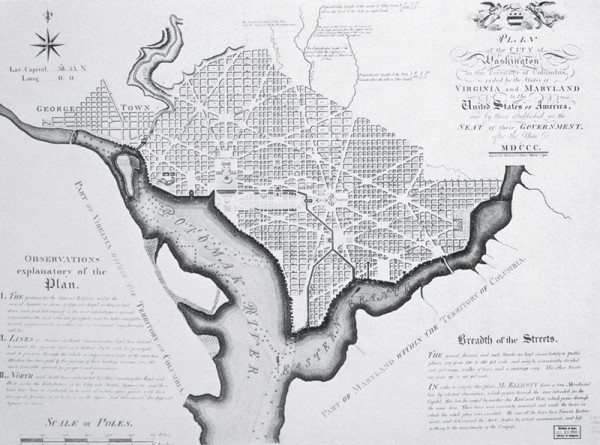
Pierre Charles L’Enfant, Plan of the City of Washington, Philadelphia, Pennsylvania, 1792. Engraving. Image, 8 1/4" x 10 1/4"; sheet, 13 3/4" x 16 15/16". (Courtesy, Library of Congress.)
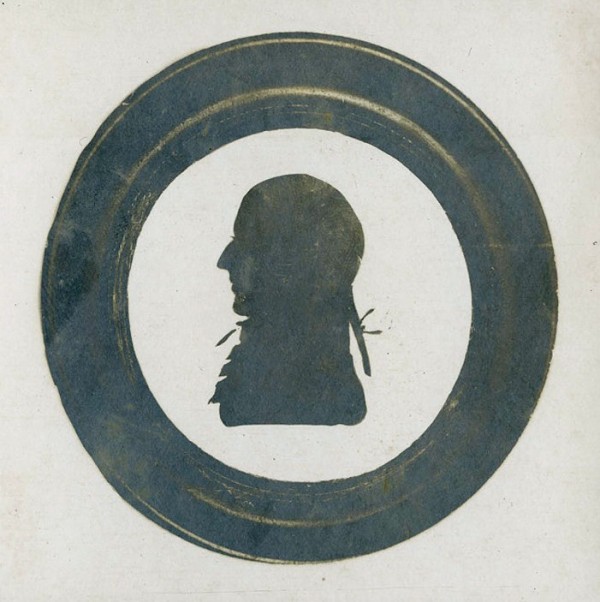
Silhouette of Henry Ingle, probably Philadelphia, Pennsylvania, 1790–1800. Paper. Diam. 3 1/8". (Courtesy, Historical Society of Washington, D.C.) The frame is original.
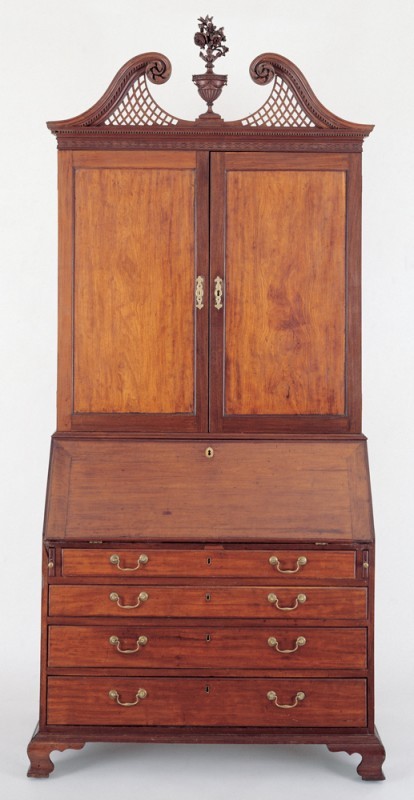
Desk-and-bookcase attributed to Henry Ingle with carving attributed to William Hodgson, Richmond, Virginia, 1789. Mahogany and mahogany veneer with yellow pine, tulip poplar, walnut, birch, and cherry. H. 99 1/2", W. 44 3/8", D. 21 1/2". (Private collection; photo, Gavin Ashworth.)
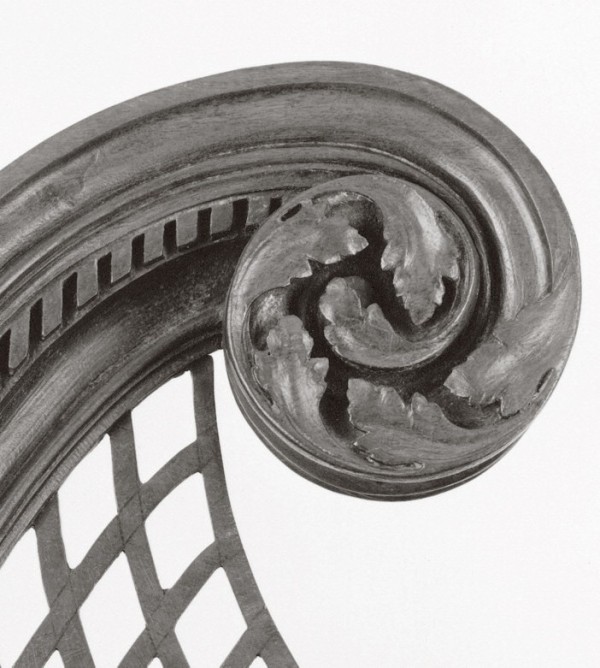
Detail of the rosette of the desk-and-bookcase illustrated in fig. 5. (Photo, Gavin Ashworth.)
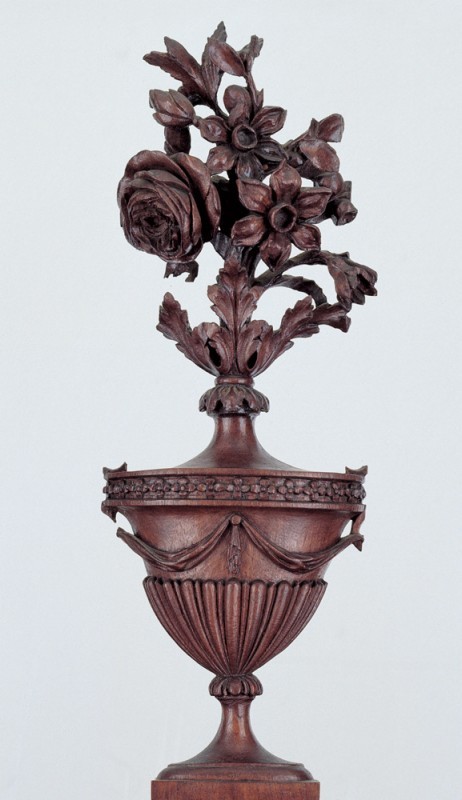
Detail of the urn-and-flower ornament of the desk-and-bookcase illustrated in fig. 5. (Photo, Gavin Ashworth.)

Architectural carving attributed to William Hodgson, Woodlands, Amelia County, Virginia, ca. 1790. (Photo, Katherine Wetzel.) Clotworthy Stephenson furnished the plaster ornaments. The architectural components were fabricated and carved in Richmond and shipped to Amelia County.
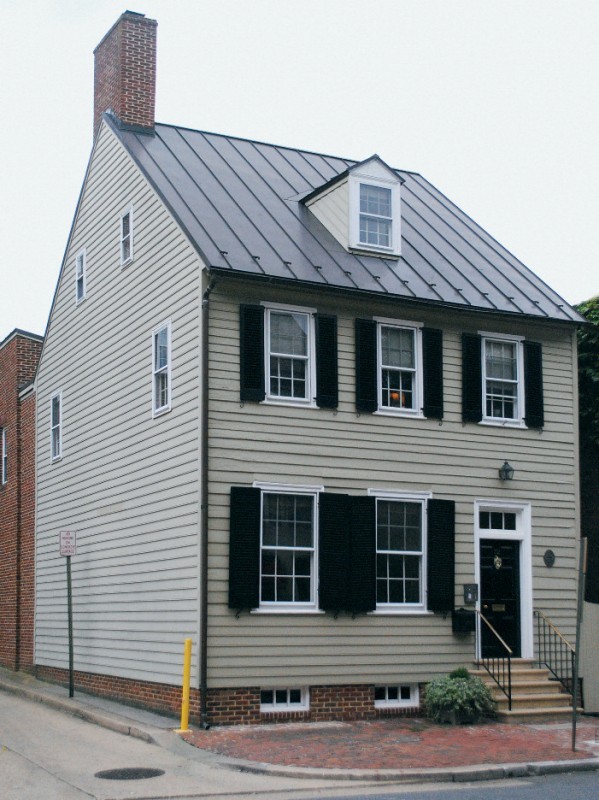
112 South Royal Street, Alexandria, Virginia, before 1795. (Photo, Christian Meade.) Joseph Ingle acquired this property in 1795 and maintained a cabinetmaking shop until 1816. His brother Henry worked with him at the site from 1798 to 1801 and possibly earlier.
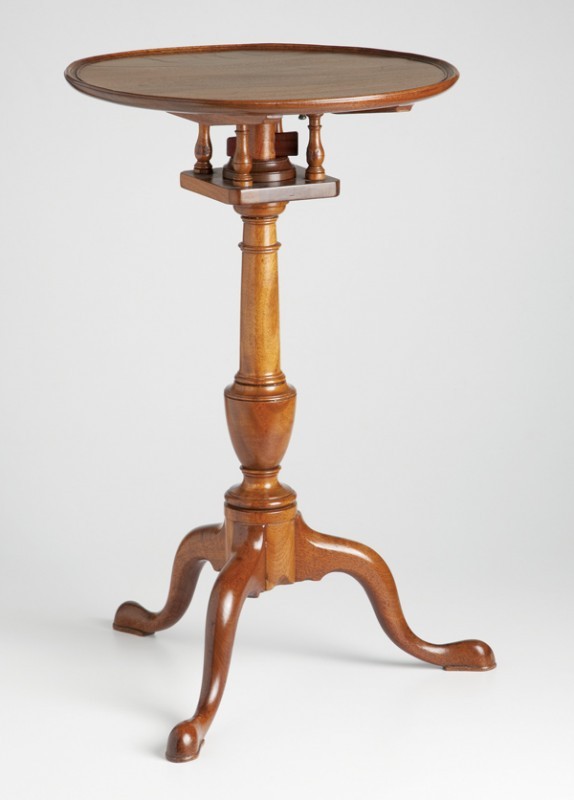
Candle stand attributed to Henry Ingle, Philadelphia, Pennsylvania, or Alexandria, Virginia, 1790–1800, Mahogany. H. 28 1/2", D. 17 1/4". (Private collection; photo, Gavin Ashworth.) The label reads: “Mahogany candle-stand, probably made in Philadelphia . . . by H. Ingle or in his shop. . . . came from Mary Pechin, wife of Henry Ingle.”
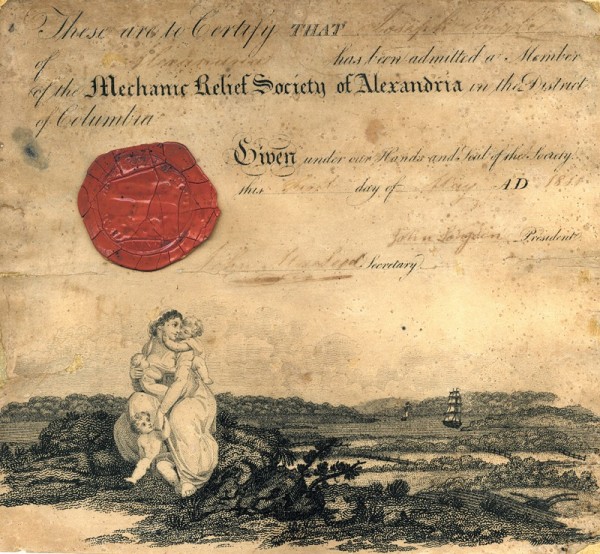
Joseph Ingle’s membership certificate in the Mechanic Relief Society of Alexandria, unknown engraver and printer, Alexandria, Virginia, dated 1811. Copperplate engraving on paper. 8" x 8 3/4". (Courtesy, Museum of Early Southern Decorative Arts.)
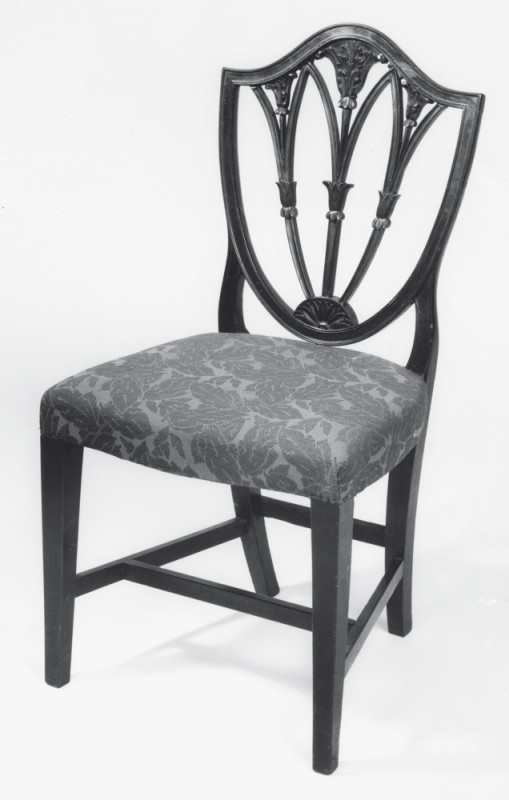
Side chair, Alexandria, Virginia, 1795–1800. Mahogany with tulip poplar. H. 37 1/2", W. 20", D. 17". (Courtesy, National Museum of American History; photo, Museum of Early Southern Decorative Arts.)
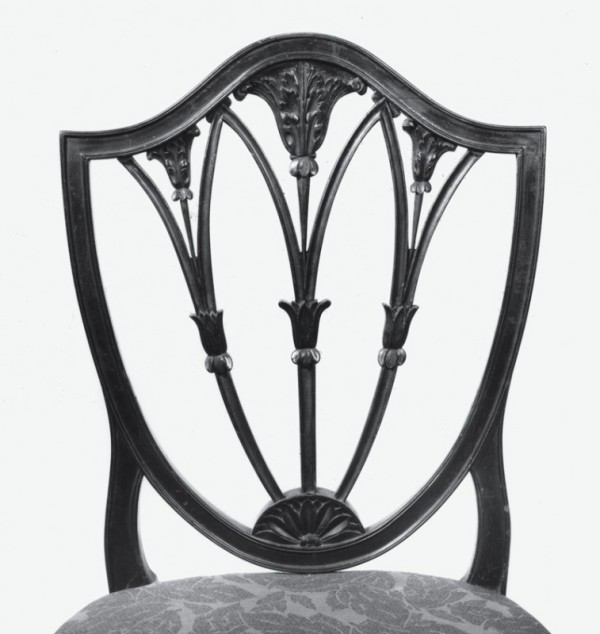
Detail of the back of the side chair illustrated in fig. 12.
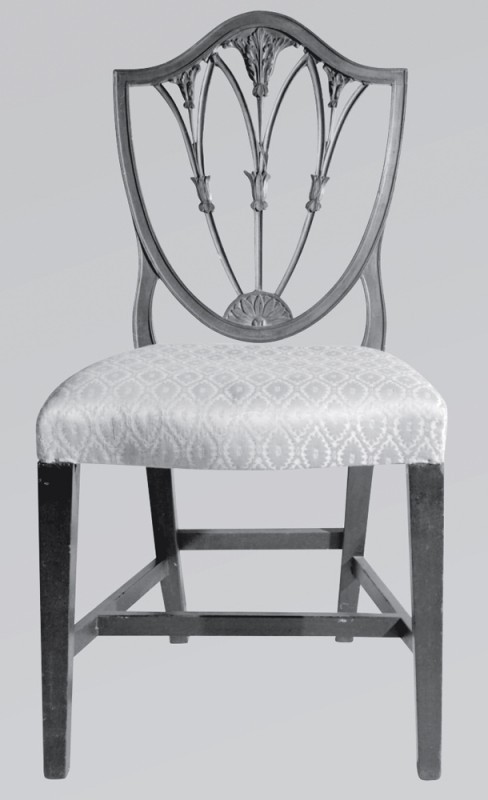
Side chair, Alexandria, Virginia, 1795–1800. Mahogany with oak. H. 37 1/2", W. 19", D. 17". (Courtesy, Sully Plantation; photo, Museum of Early Southern Decorative Arts.)
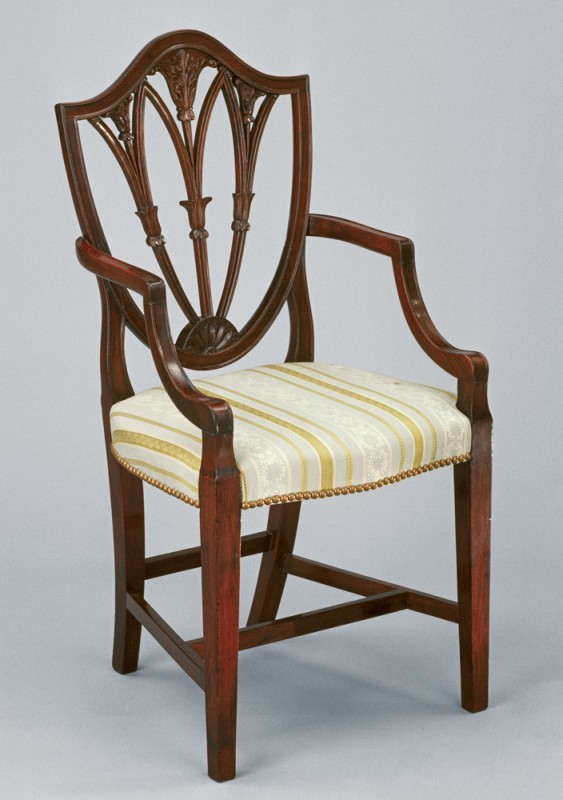
Armchair, Alexandria, Virginia, or Washington, D.C., 1795–1805. Mahogany with oak and tulip poplar. H. 37 1/2", W. 18 5/8", D. 16 1/4". (Courtesy, Colonial Williamsburg Foundation.) The arms are early additions.
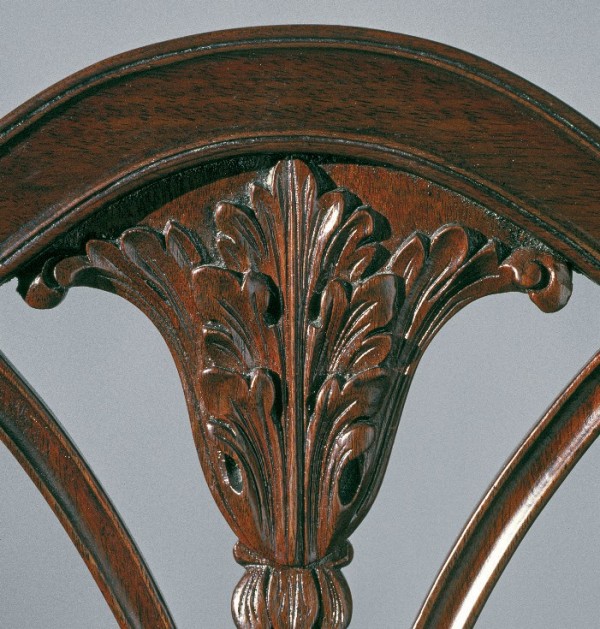
Detail of the carved acanthus leaves on the armchair illustrated in fig. 15.
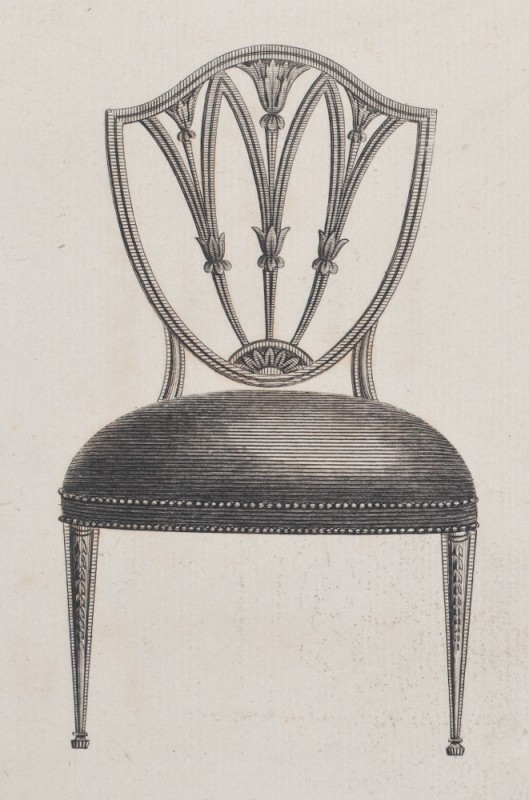
Design for a side chair illustrated on pl. 5 of George Hepplewhite’s Cabinet-Maker and Upholsterer’s Guide (3rd ed., 1794). (Courtesy, Winterthur Museum.)
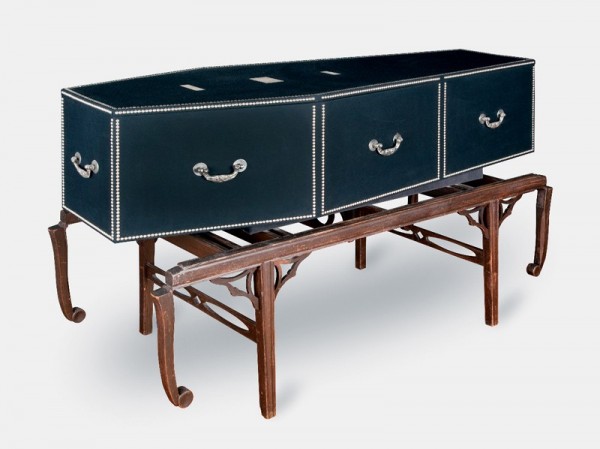
Catafalque, possibly by Henry or Joseph Ingle, Alexandria, Virginia, 1790–1800. Walnut. H. 26 3/4", L. 113 1/2" (with handles), D. 33 3/4". (Courtesy, Mount Vernon Ladies Association of the Union; photo, Dennis McWaters.)
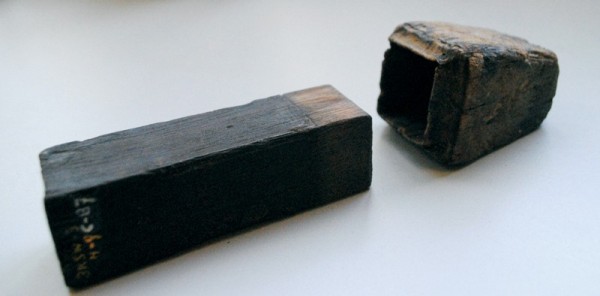
Fragment of a tapered leg with spade foot, possibly Joseph Ingle, Alexandria, Virginia, 1795–1805. Mahogany. Dimensions not recorded. (Courtesy, Alexandria Archaeology Museum; photo, Christian Meade.)
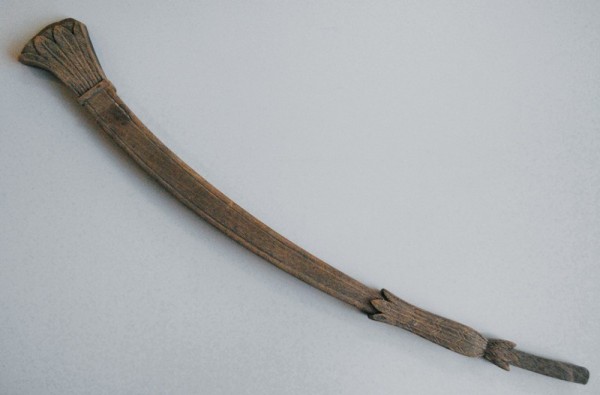
Excavated banister from an urn-back chair, possibly Joseph Ingle, Alexandria, Virginia, 1795–1805. Dimensions not recorded. (Courtesy, Alexandria Archaeology Museum; photo, Christian Meade.)
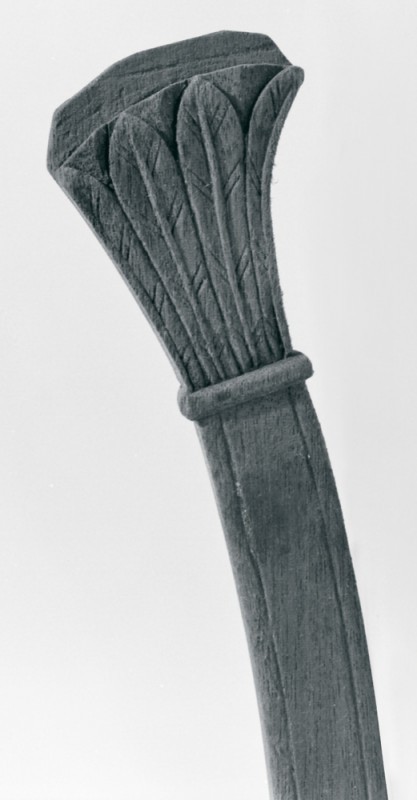
Detail of the carving on the chair banister illustrated in fig. 20.
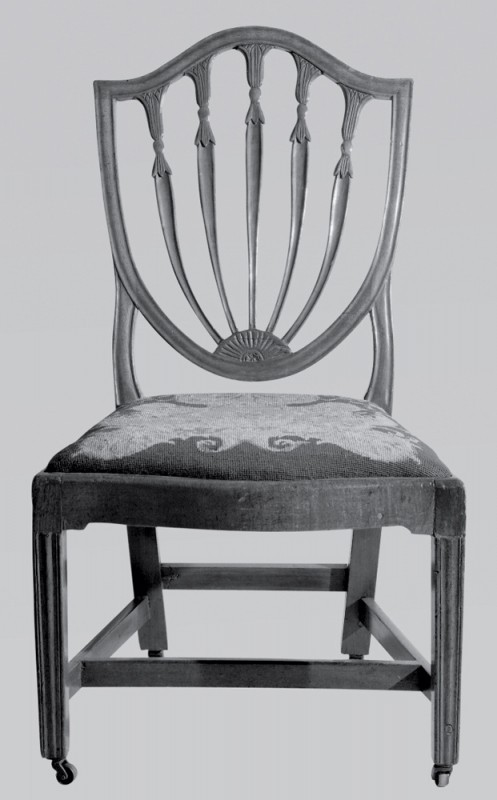
Side chair, possibly Joseph Ingle, Alexandria, Virginia, 1795–1800. Mahogany with tulip poplar. H. 37 3/4", W. 21", D. 19 1/4". (Courtesy, Gadsby’s Tavern Museum, City of Alexandria; photo, Museum of Early Southern Decorative Arts.)
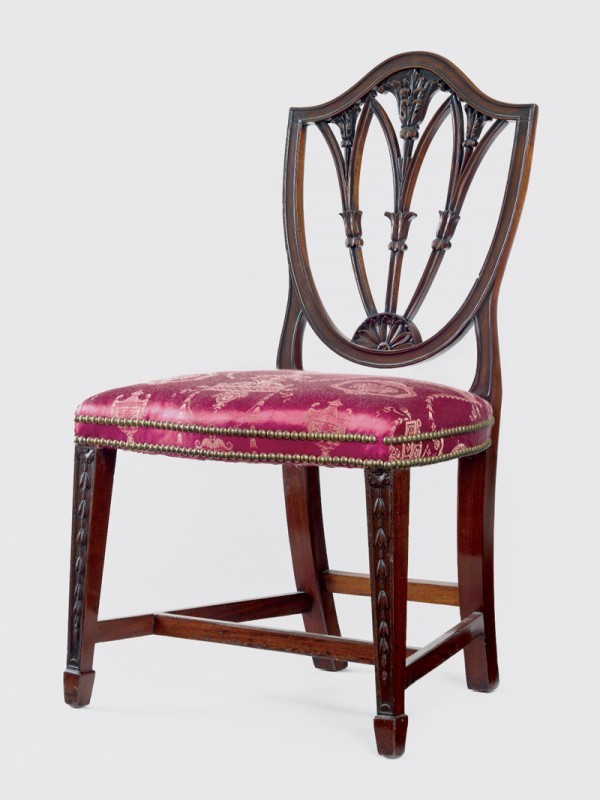
Side chair attributed to Henry Ingle, possibly with Isaac Pelton, Washington, D.C., 1801–1802. Mahogany and oak. H. 37 1/2", W. 21", D. 17 1/8”. (Courtesy, Maryland Historical Society; photo, Gavin Ashworth.)

Detail of the leg carving on the chair illustrated in fig. 23. (Photo, Gavin Ashworth.)
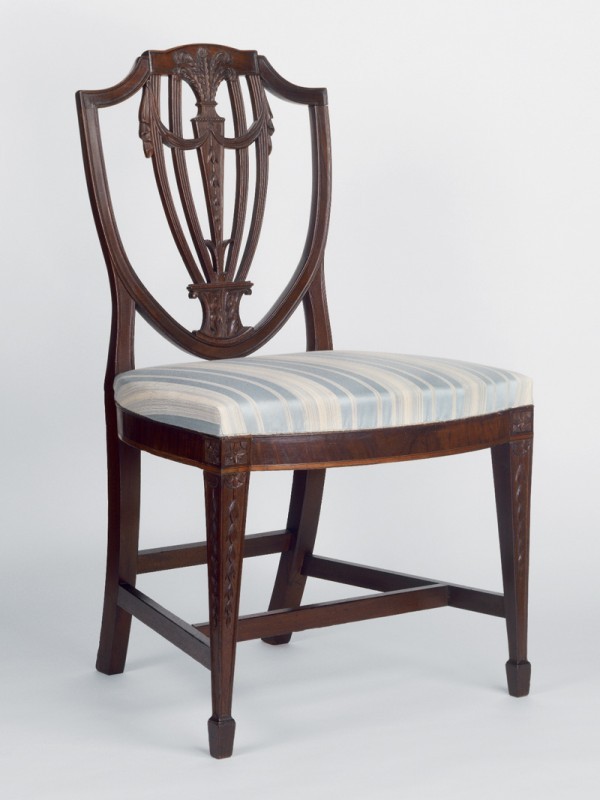
Side chair attributed to Henry Ingle, possibly with Isaac Pelton, Washington, D.C., 1801–1802. Mahogany with walnut, cherry, tulip poplar, and mahogany. H. 36 1/2", W. 20 3/4", D. 19". (Courtesy, Winterthur Museum.) This is the earliest Washington seating form with half-over-the-rail upholstery.
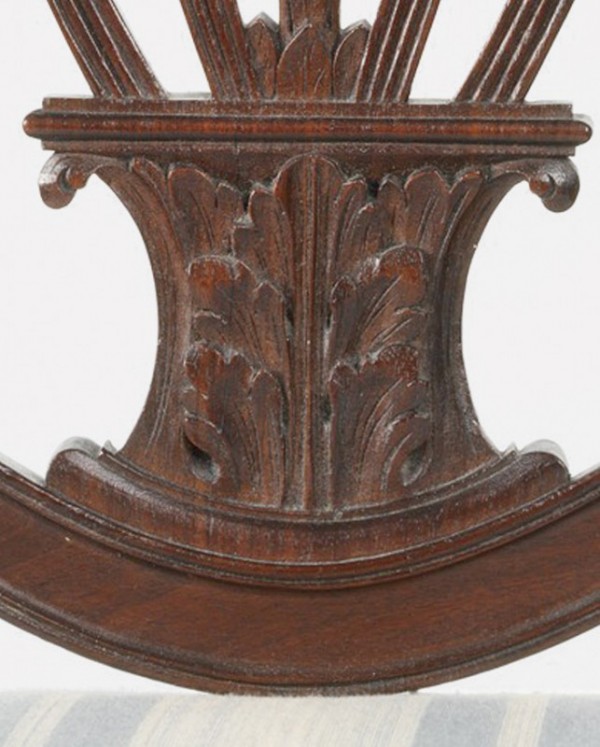
Detail of the acanthus leaf in the back splat of the chair illustrated in fig. 25.
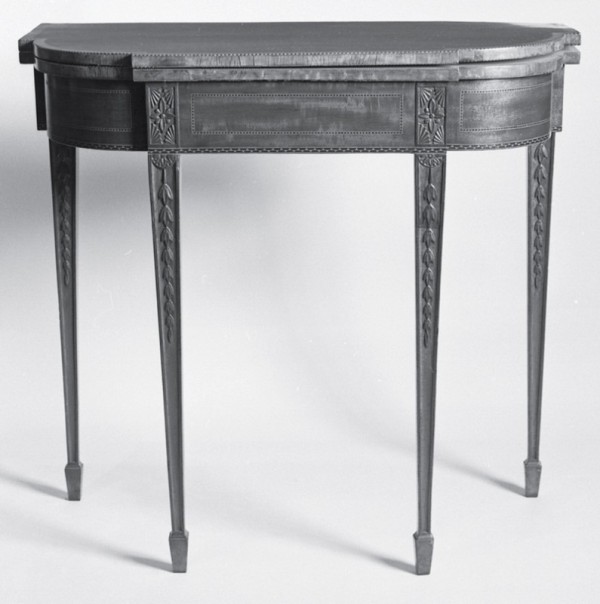
Card table, American, Baltimore, Maryland, attributed to Henry Ingle, 1785–1800. Mahogany, mahogany veneer, tulip wood, oak. H. 29 1/4", W. 30 5/8", D. 15". (Courtesy, The Baltimore Museum of Art: gift of Mrs. Harry B. Dillehunt, Jr., in memory of her husband, BMA 1978.60.1; photo, Mitro Hood.)
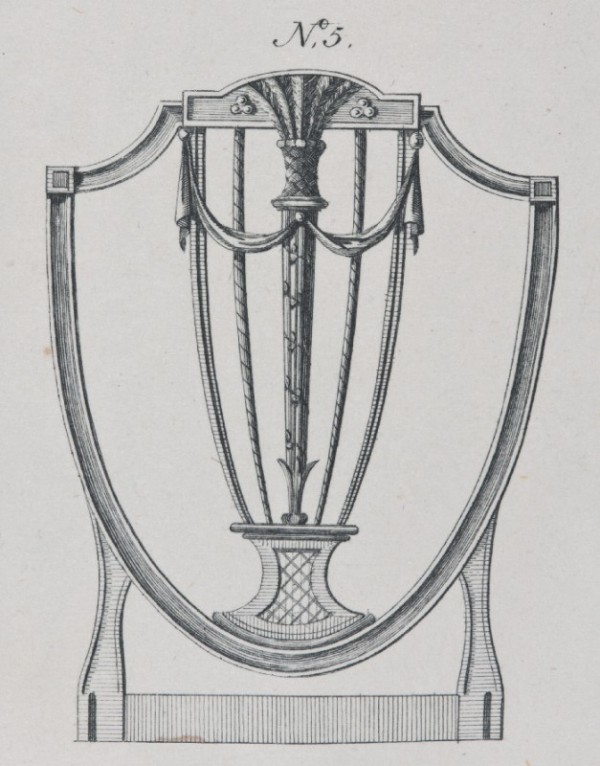
Design for a chair back illustrated on pl. 36, of Thomas Sheraton’s Cabinet-Maker and Upholsterer’s Drawing Book (1793). (Courtesy, Winterthur Museum.)
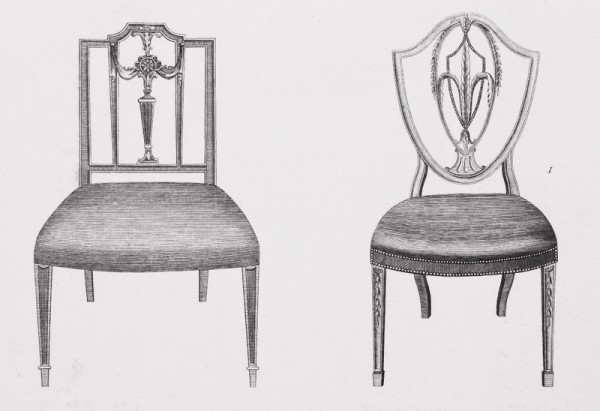
Design for “Chairs” illustrated on pl. 6 of George Hepplewhite’s Cabinet-Maker and Upholsterer’s Guide (3rd ed., 1794). (Courtesy, Winterthur Museum.) The chair on the left was the source for the back of the Harper chairs, and the chair on the right was the source for the half rosette and graduated husks on the Harper chairs and other seating attributed to Henry Ingle.
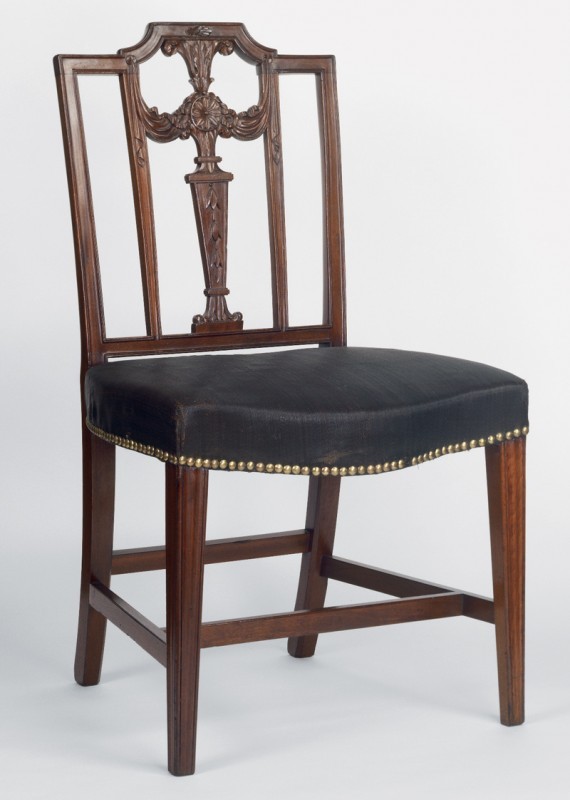
Side chair attributed to Henry Ingle, Washington, D.C., 1800–1805. Mahogany with tulip poplar and yellow pine. H. 36 1/2", W. 20", D. 18 1/2". (Courtesy, Winterthur Museum.)
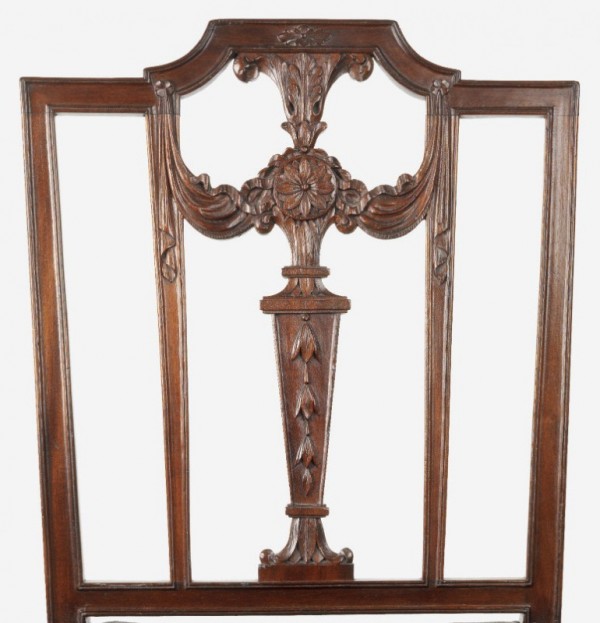
Detail of the back of the chair illustrated in fig. 30.
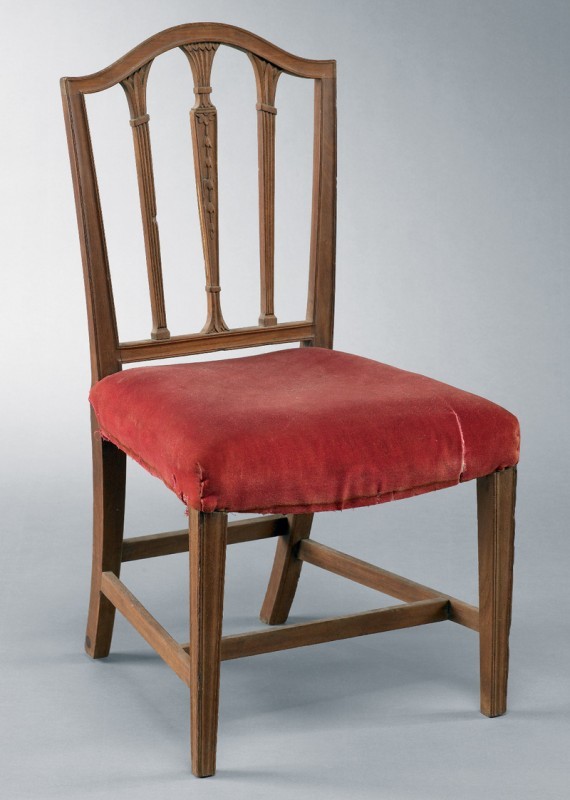
Side chair attributed to Henry Ingle, Washington, D.C., 1800–1805. Mahogany with oak. H. 37 1/4", W. 20", D. 21". (Private collection; photo, Astorino.)
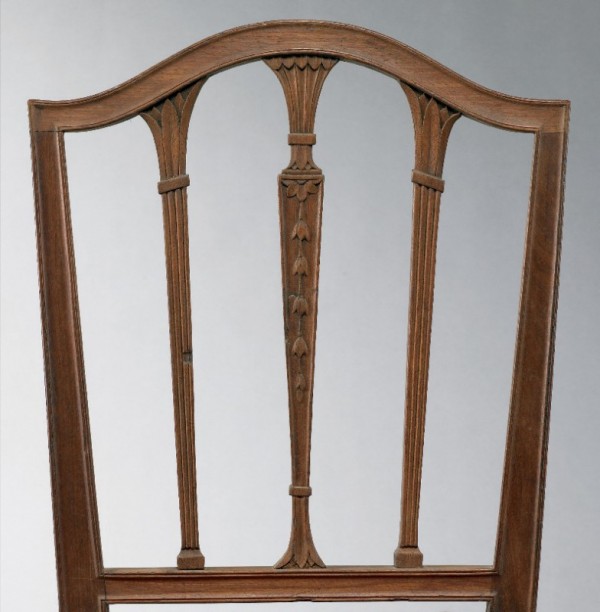
Detail of the back of the chair illustrated in fig. 32.
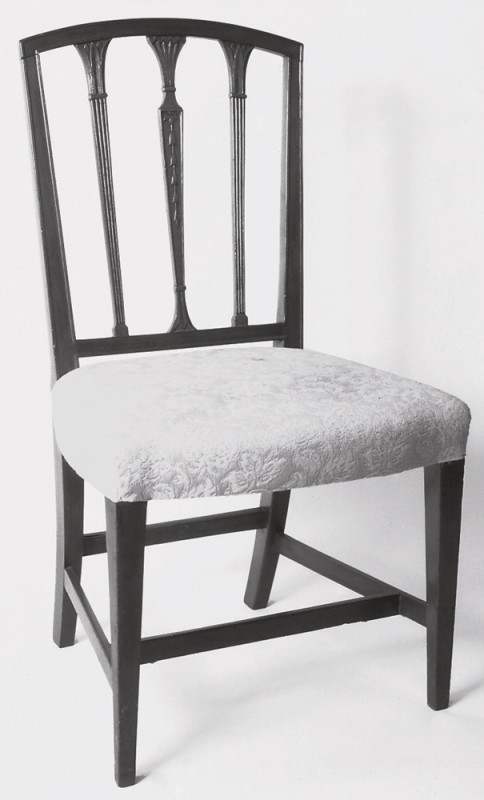
Side chair, Washington, D.C., 1800–1810. Mahogany with ash. H. 36 1/2", W. 19 3/8", D. 17 1/4". (Private collection; photo, Museum of Early Southern Decorative Arts.)
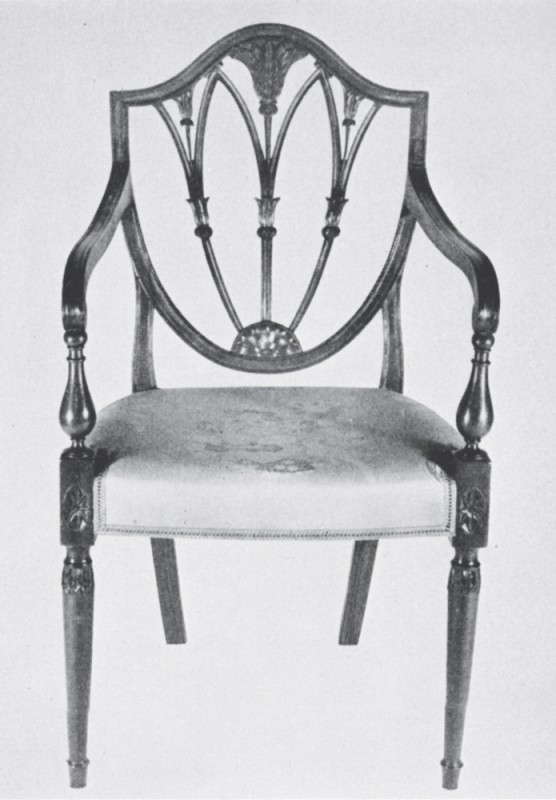
Armchair, Washington, D.C., ca. 1800. Mahogany. (Baltimore Furniture: The Work of Baltimore and Annapolis Cabinetmakers from 1760 to 1810 [Baltimore, Md.: Baltimore Museum of Art, 1947], fig. 56.)
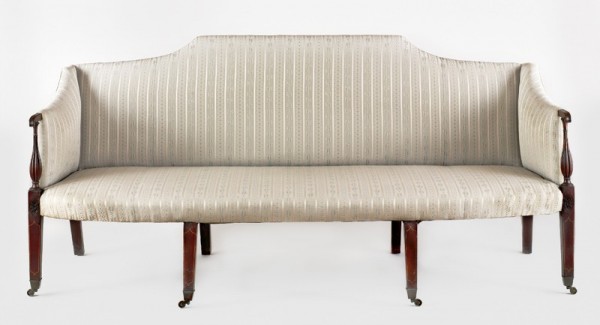
Sofa attributed to Henry and/or Joseph Ingle, Alexandria, Virginia, or Washington, D.C., 1795–1805. Mahogany and lightwood inlay; secondary woods not recorded. H. 36", W. 79", D. 37 1/4". (Courtesy, Historical Society of Frederick County, Maryland; photo, Gavin Ashworth.)

Detail of an arm and leg on the sofa illustrated in fig. 36. (Photo, Gavin Ashworth.)
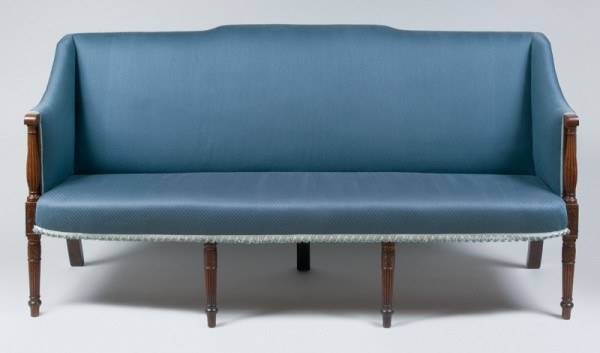
Sofa, Philadelphia, Pennsylvania, 1795–1805. Mahogany with yellow pine, white oak, and white pine. H. 22 1/2", W. 69". (Courtesy, Philadelphia Museum of Art.)
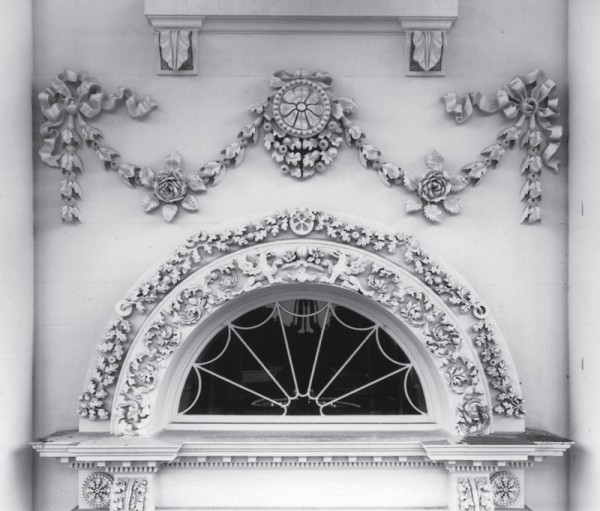
Carved ornament over the north entrance of the President’s House, attributed to David Cummings, John Davidson, James Dixon, James Dougherty, Henry Edwards, John Hogg, and/or Robert Vincent, Washington D.C., ca. 1797. Carved sandstone. (Courtesy, White House Historical Association.)
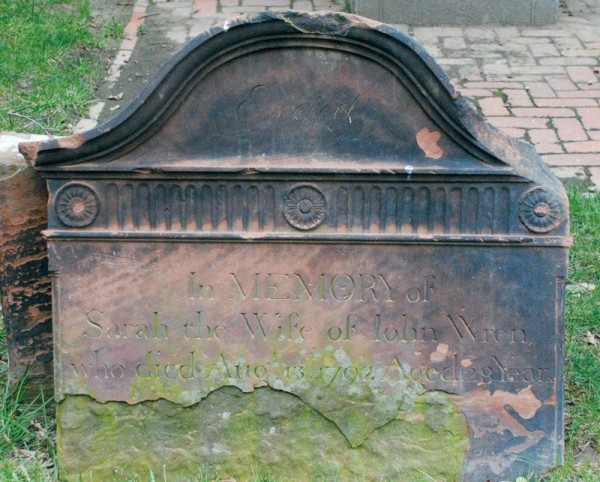
Tombstone for Sarah Wren, Christ Church, Alexandria, Virginia, after 1794. Seneca sandstone. H. 31". (Courtesy, Historic Christ Church; photo, Sumpter Priddy and Christian Meade.)
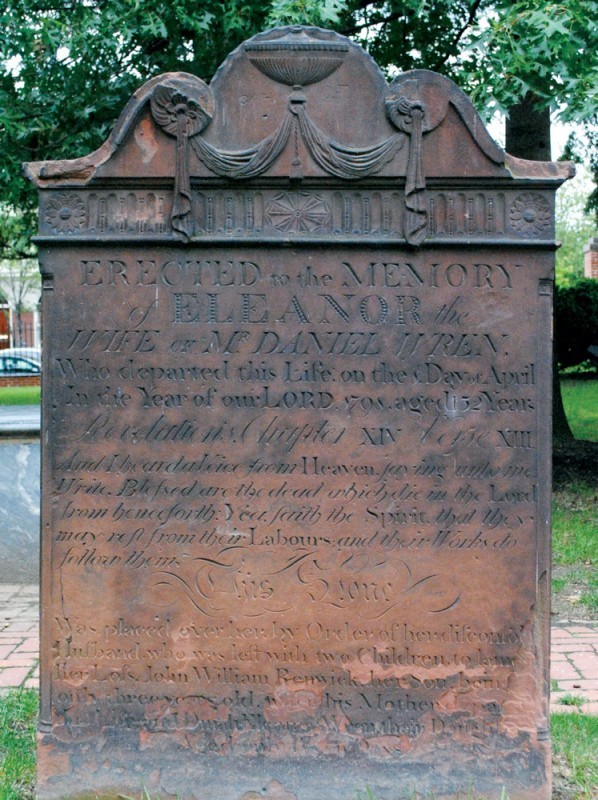
Tombstone for Eleanor Wren, Christ Church, Alexandria, Virginia, after 1798. Seneca sandstone. H. 62 1/2". (Courtesy, Historic Christ Church; photo, Sumpter Priddy and Christian Meade.)
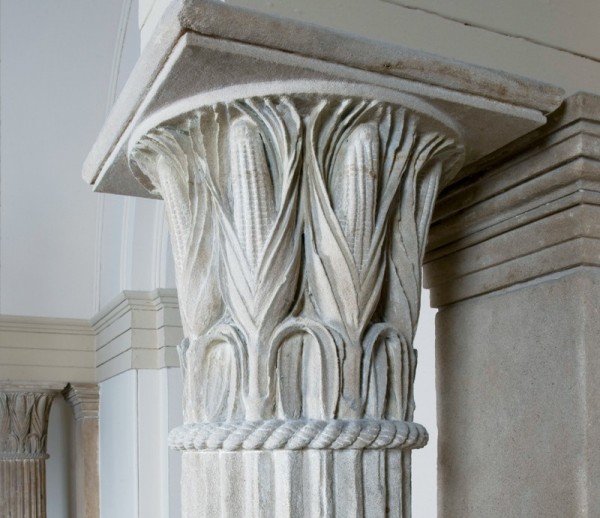
Giuseppe Franzoni after a design by Benjamin Henry Latrobe, capital, U.S. Senate vestibule, 1809. Aquia sandstone. (Courtesy, Architect of the Capitol.)
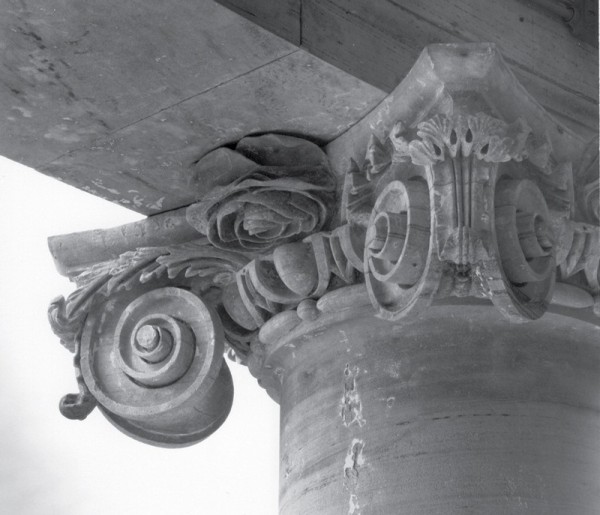
Giovanni Andrei, capital, White House South Portico, ca. 1815. Aquia sandstone. (Courtesy, White House Historical Association.)
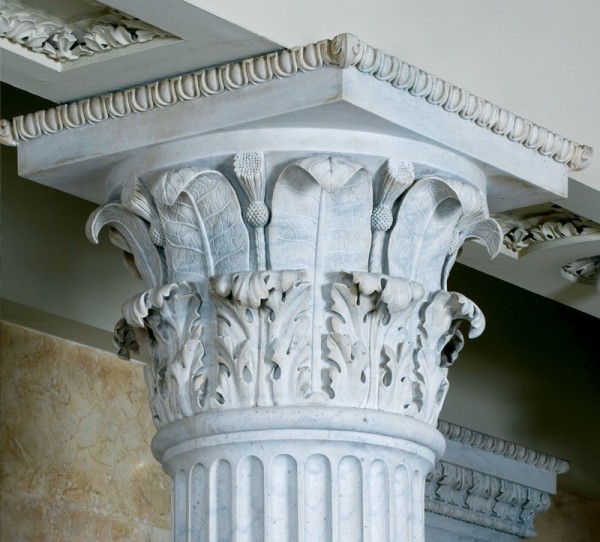
Francesco Iardella after a design by Benjamin Henry Latrobe, capital, U.S. Senate Rotunda, 1816. Aquia sandstone. (Courtesy, Architect of the Capitol.)
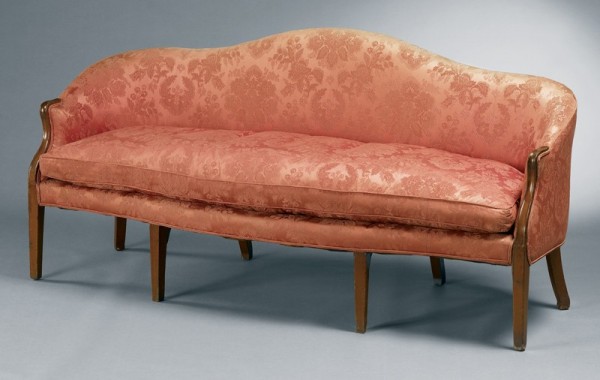
Sofa attributed to William Waters or William Worthington, District of Columbia, 1795–1805. Mahogany with tulip poplar and yellow pine. H. 36 1/2", W. 77 1/2", D. 24". (Private collection; photo, Sumpter Priddy.)
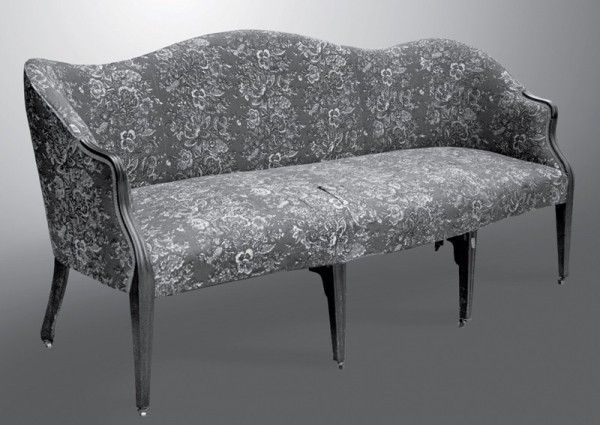
Sofa attributed to William Waters or William Worthington, District of Columbia, 1795–1805. Mahogany with tulip poplar and yellow pine. H. 36 1/2", W. 77 1/2", D. 34". (Private collection; photo, Sumpter Priddy.)
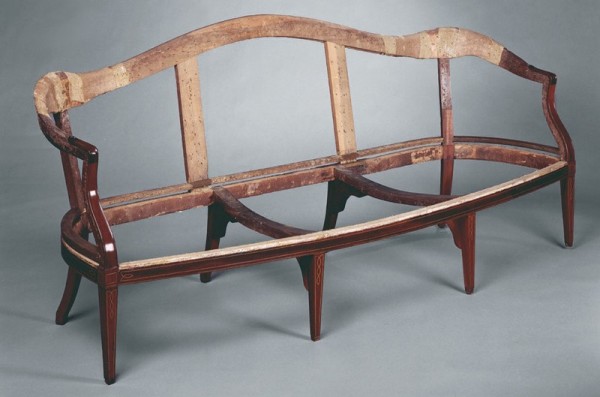
Sofa attributed to William Waters or William Worthington, District of Columbia, 1795–1805. Mahogany with tulip poplar and yellow pine. H. 36 1/2", W. 77 1/2", D. 24". (Private collection; photo, Astorino.) The sofa has its original casters, but they are not shown here.
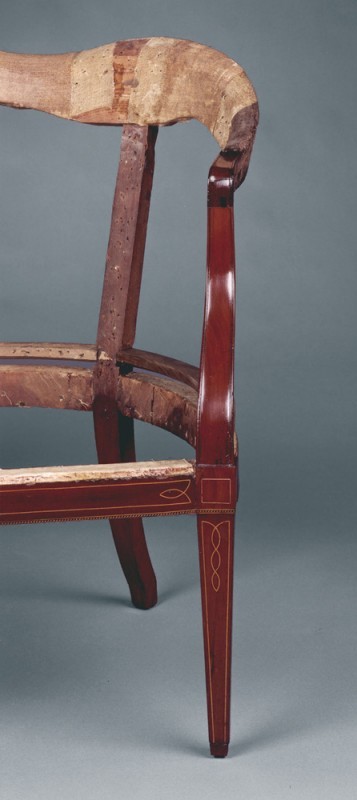
Detail of the right arm and leg of the sofa illustrated in fig. 47.
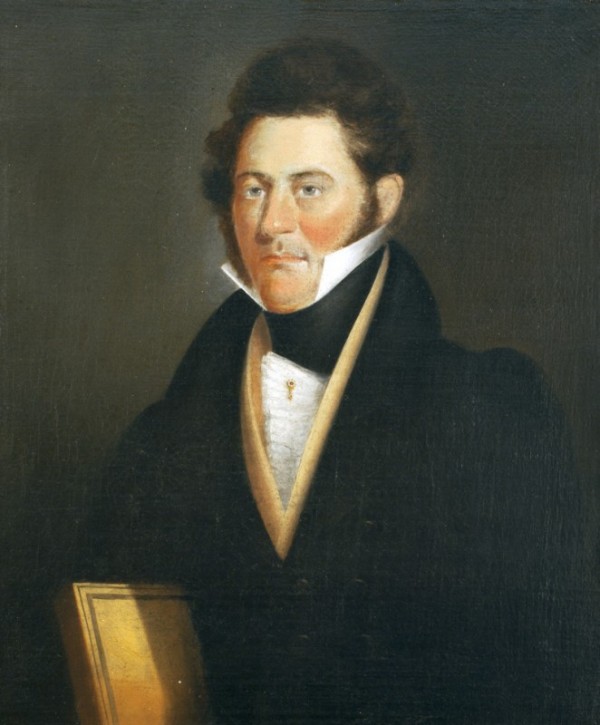
William Worthington, Washington, D.C. or Frederick, Maryland, 1820–1825. Oil on canvas. 30" x 25". (Private collection; photo, Philip Beaurline.)
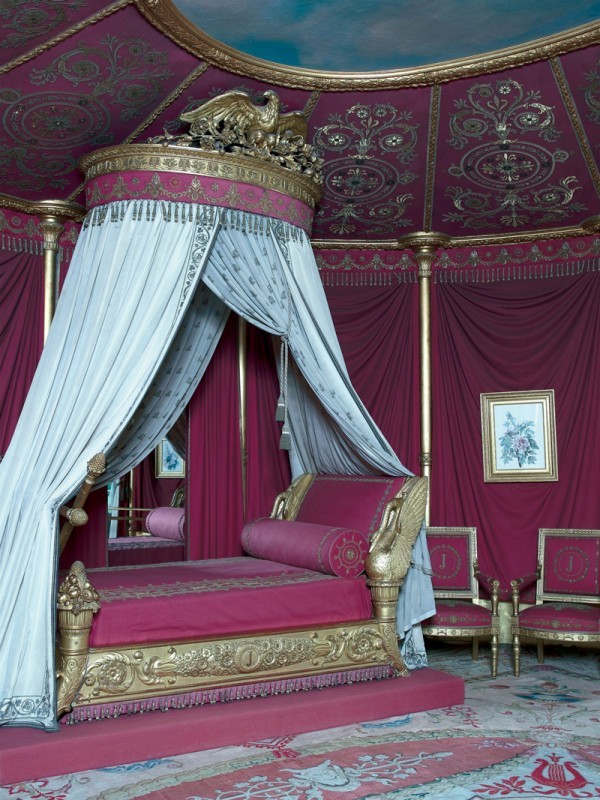
French bedstead attributed to Jacob Desmalter and Co. after a design by Charles Percier and Pierre-François-Léonard Fontaine, Château de Malmaison, Rueil-Malmaison, France, 1799–1803. (Courtesy, Réunion des Musées Nationaux; photo, Art Resource, NY.)
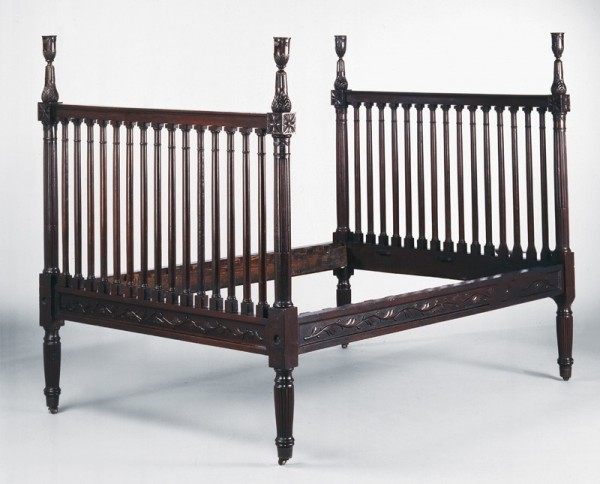
French bedstead attributed to William Worthington, Washington, D.C., 1818–1819. Mahogany with yellow pine. H. 61 1/2" (with finials), L. 77", W. 53 1/4". (Courtesy, James Monroe Memorial Foundation.)
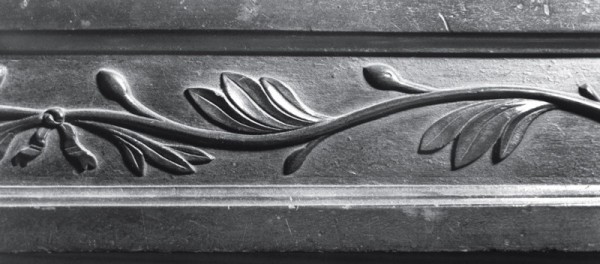
Detail of the carved rail on the French bedstead illustrated in fig. 51.
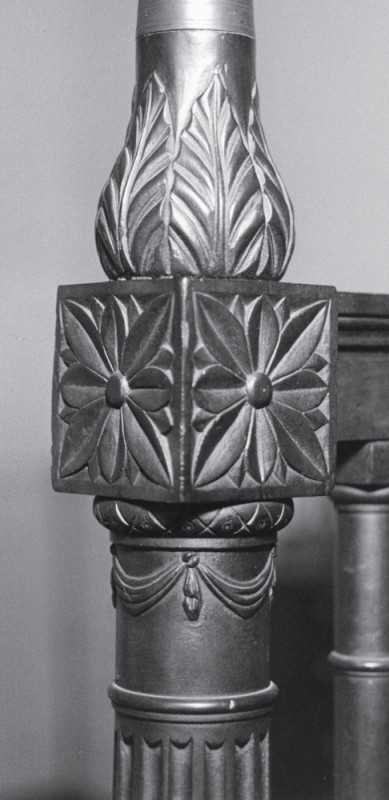
Detail of the carved post on the French bedstead illustrated in fig. 51.
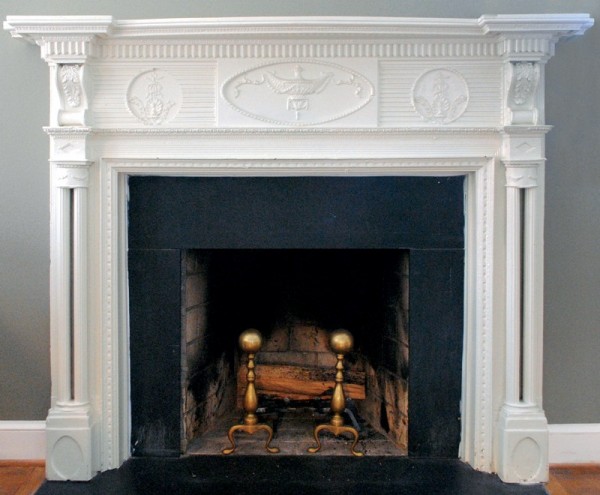
Chimneypiece in a second-floor room in the Bank of Alexandria, 133 North Fairfax, Alexandria, Virginia, 1807. (Courtesy, Northern Virginia Regional Park Authority; photo, Christian Meade.) The composition ornament is attributed to George Andrews. The President’s House probably had similar chimneypieces.
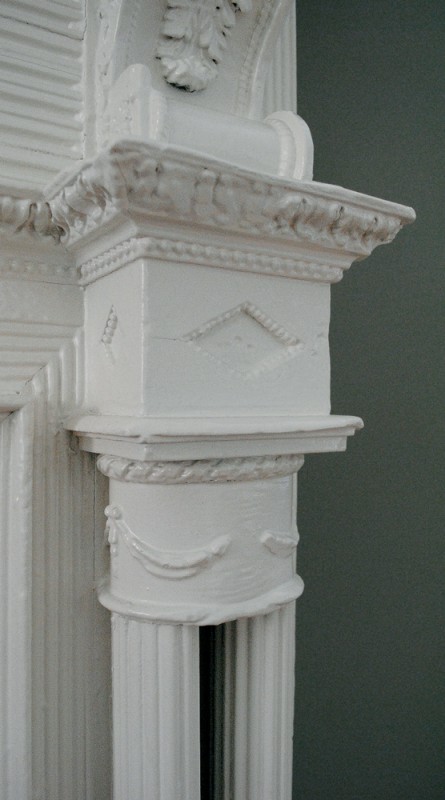
Detail of the composition ornament on the chimneypiece illustrated in fig. 54.
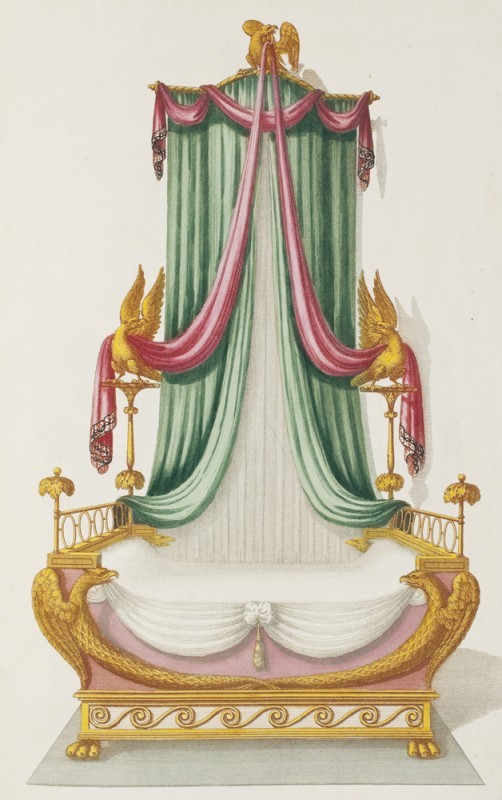
“Canopy Bed” illustrated on pl. 6 of Thomas Sheraton’s Cabinet-Maker and Upholsterer’s Drawing Book (1804). (Courtesy, Winterthur Museum.)
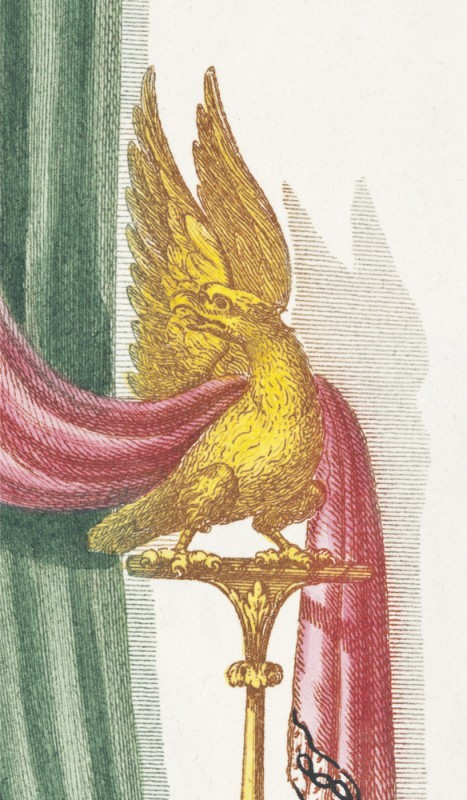
Detail of the plate illustrated in fig. 56. (Courtesy, Winterthur Museum.)
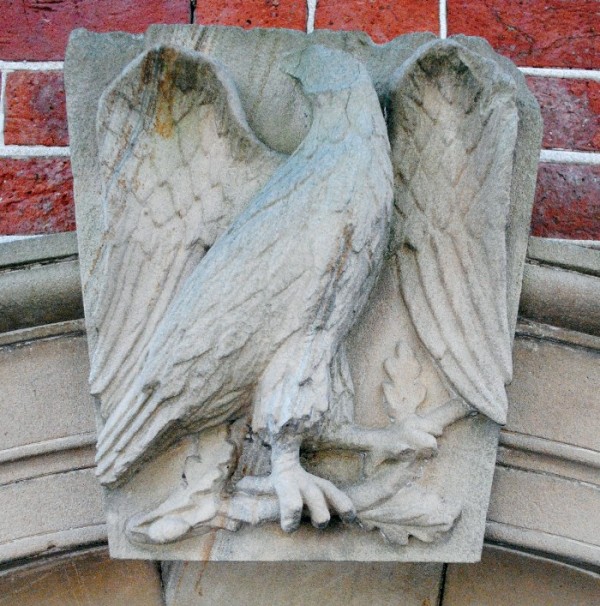
Keystone, Bank of Alexandria, Alexandria, Virginia, 1807. Aquia sandstone. (Courtesy, Northern Virginia Regional Park Authority; photo, Christian Meade.)
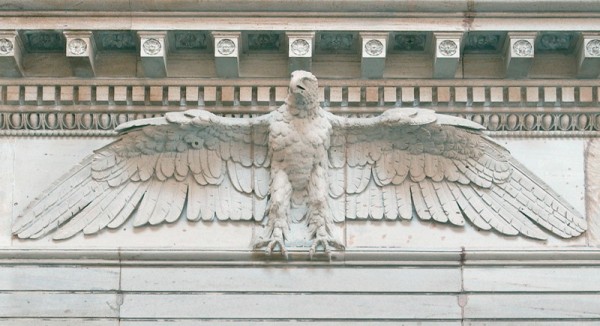
Giuseppi Valaperta, eagle in the Hall of Statues, U.S. Capitol, 1815. Aquia sandstone. (Courtesy, Architect of the Capitol.)
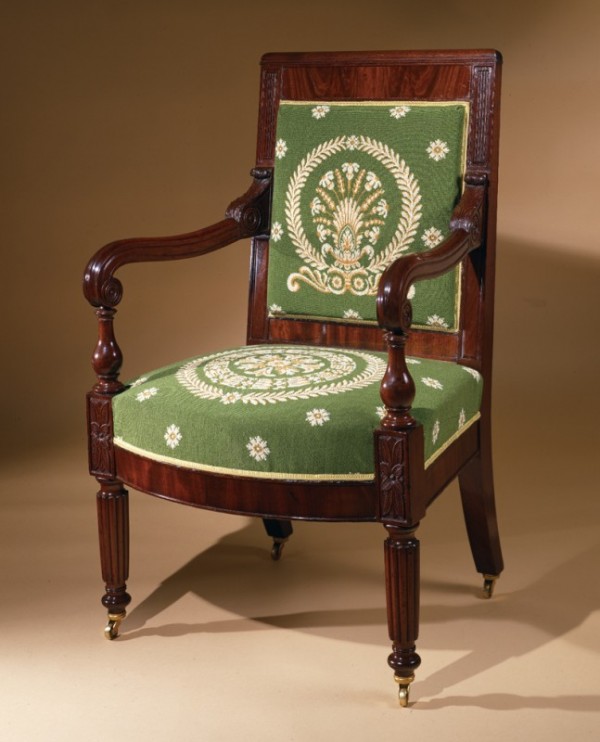
Armchair attributed to William King Jr., Georgetown, D.C., 1818. Mahogany with ash and maple. H. 40 7/8", W. 25 1/2", D. 25 1/8". (Courtesy, Collection of Ash Lawn Highland; photo, Hirschl & Adler Galleries, New York.)
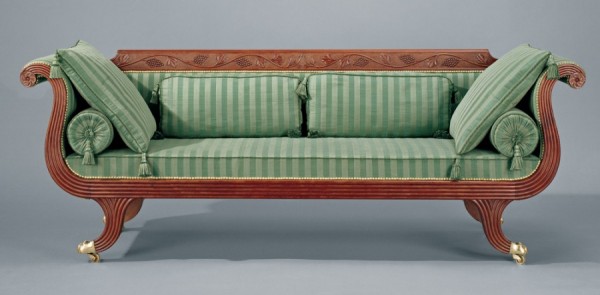
Sofa attributed to William King Jr., Georgetown, D.C., 1815–1825. Mahogany with walnut and yellow pine; brass casters. H. 32 7/8", W. 89 1/4", D. 25 1/4". (Courtesy, Colonial Williamsburg Foundation.)
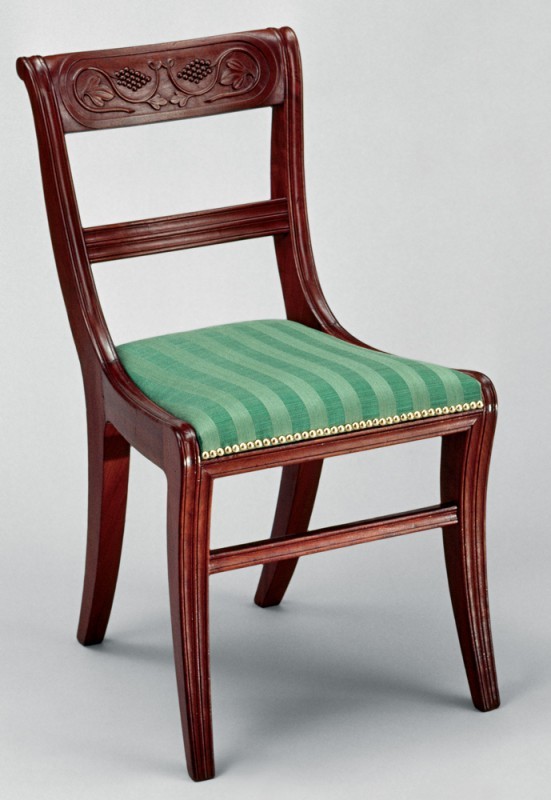
Side chair attributed to William King Jr., Georgetown, D.C., 1815–1825. Mahogany with tulip poplar and white pine. H. 32 5/8", W. 17 7/8", D. 16". (Courtesy, Colonial Williamsburg Foundation.) Saber legs are rare on Washington seating.
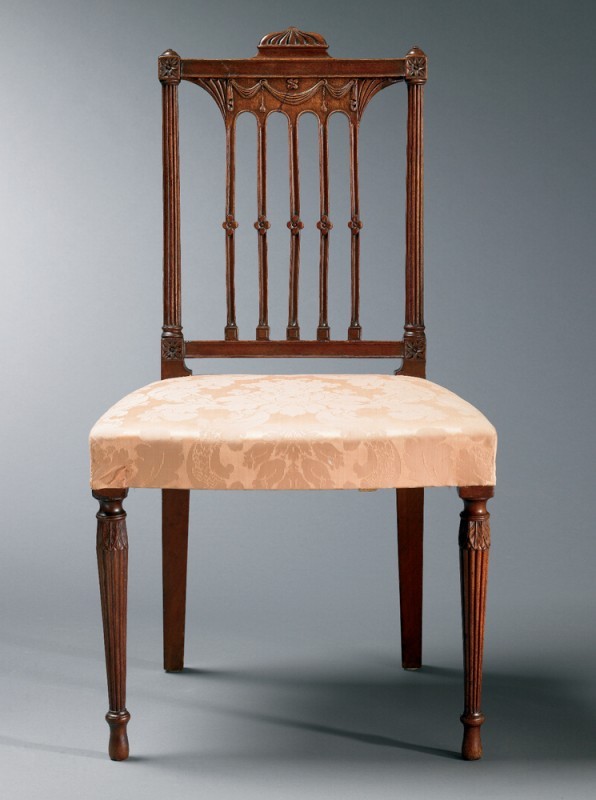
Side chair attributed to William Worthington, Washington, D.C., 1805–1815. Mahogany with ash and yellow pine. H. 37 1/2," W. 18 1/2", D. 17 1/4". (Private collection; photo, Astorino.)
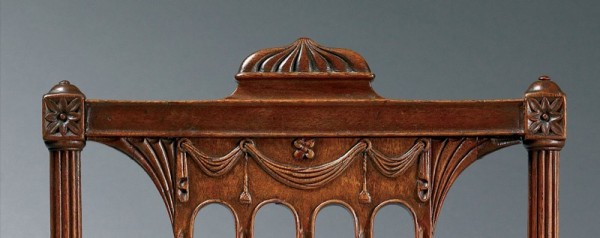
Detail of the carved crest of the chair illustrated in fig. 63.
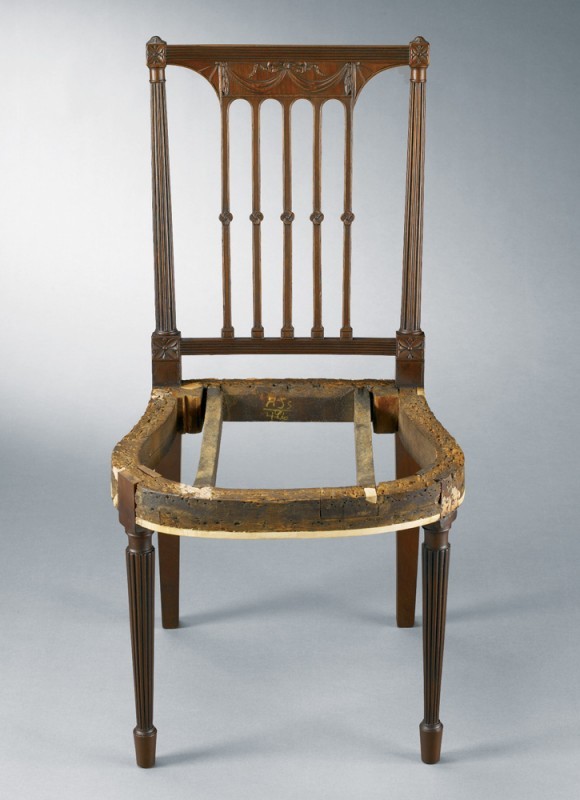
Side chair attributed to William Worthington, Washington, D.C., 1805–1815. Mahogany with ash, yellow pine, cherry, and mahogany. H. 36 1/4", W. 18 1/2", D. 17 1/4". (Private collection; photo, Astorino.)
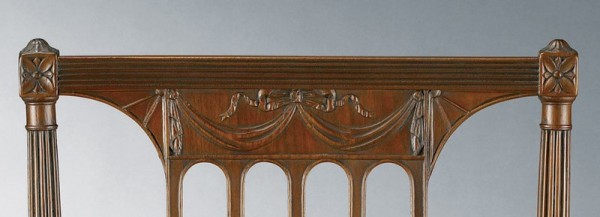
Detail of the carved crest of the side chair illustrated in fig. 65.
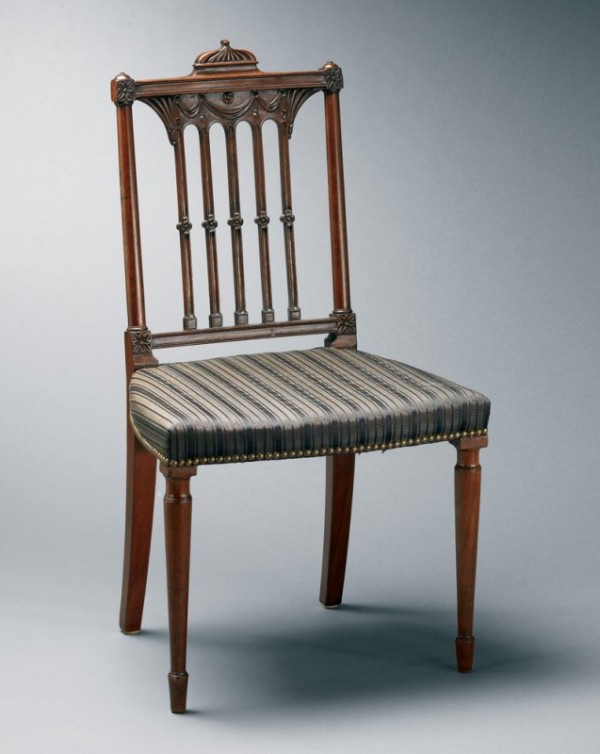
Side chair attributed to William Worthington, Washington, D.C., 1805–1815. Mahogany with yellow pine, ash, cherry, and mahogany. H. 33", W. 18 1/2", D. 17 1/4". (Private collection; photo, Astorino.) This chair is from a set that descended in the family of Dr. Reverdy Ghiselin (1765–1823) and his wife, Margaret (1783–1850), who lived near Nottingham in Prince George's County, Maryland.
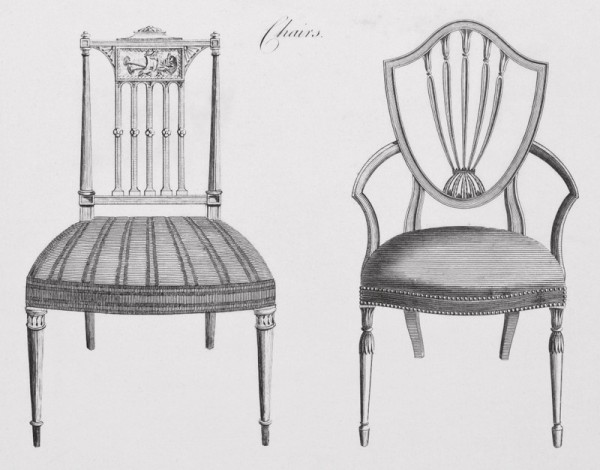
Designs for chairs illustrated on pl. 9 of George Hepplewhite’s Cabinet-Maker and Upholsterer’s Guide (1794). (Courtesy, Winterthur Museum.)
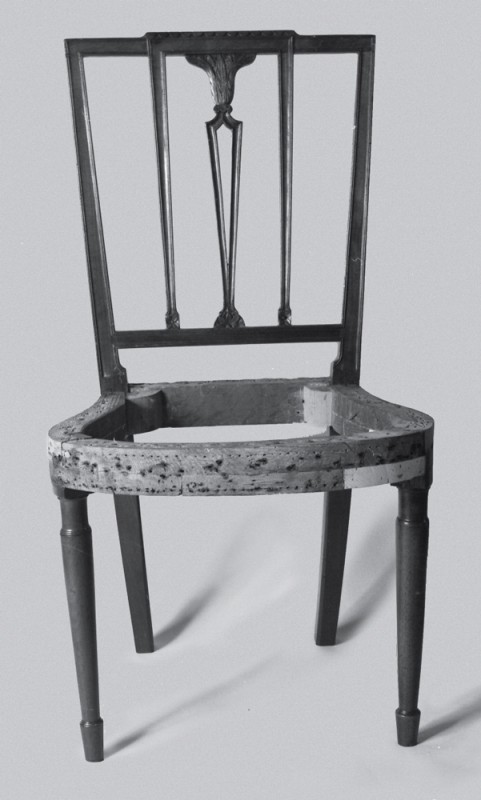
Side chair attributed to William Worthington, Washington, D.C., 1805–1815. Mahogany and mahogany veneer with oak. H. 35 3/4", W. 19 3/4", D. 16 3/8". (Private collection; photo, Museum of Early Southern Decorative Arts.) This chair is one of a pair.
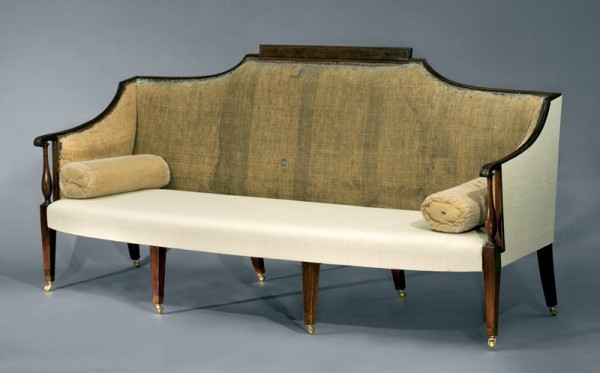
Sofa attributed to William Worthington, Washington, D.C., 1800–1810. Mahogany and mahogany veneer with mahogany, white pine, and chestnut. H. 38 1/4", W. 81", D. 30 1/2". (Courtesy, James Madison’s Montpelier.)
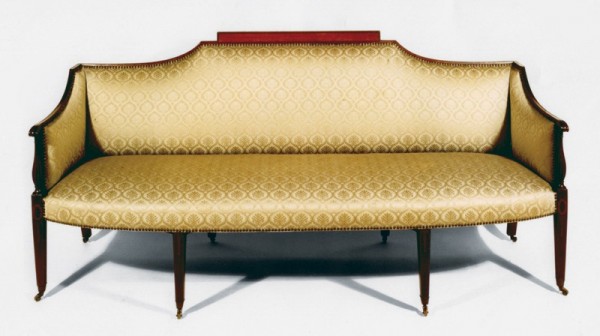
Sofa attributed to William Worthington, Washington, D.C., 1800–1810. Mahogany, satinwood, rosewood veneer and lightwood and darkwood inlays. H. 38 1/4", W. 82 1/2", D. 30 1/2". (American Antiques from Israel Sack Collection, 10 vols. [Washington, D.C.: Highland House, 1982], 2: 1334.)
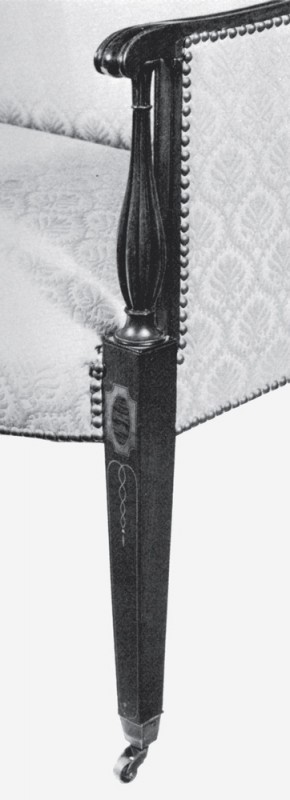
Detail of the inlay and carving on the sofa illustrated in fig. 71.
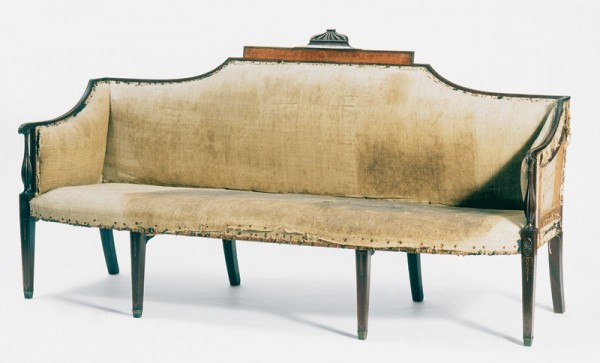
Sofa attributed to William Worthington, Washington, D.C., 1800–1810. Mahogany and satinwood veneers with mahogany, white pine, and chestnut. H. 38 1/4", W. 81", D. 30 1/2". (Private collection; photo, Marc Anderson.)
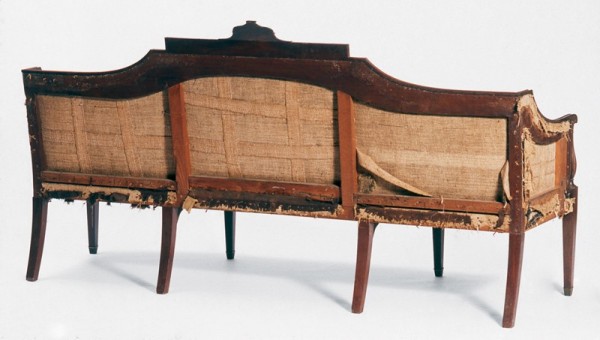
A view of the back of the sofa illustrated in fig. 73. (Private collection; photo, Marc Anderson.)

Detail of the inlaid and carved leg on the sofa illustrated in fig. 73.
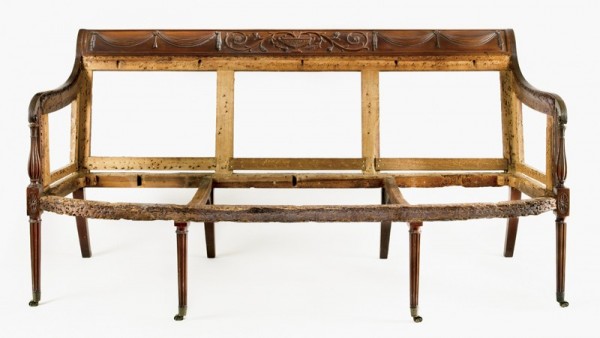
Sofa attributed to William Worthington, Washington, D.C., 1810–1811. Mahogany with tulip poplar. H. 39", W. 77 7/8", D. 25 5/8". (Courtesy, Pearre-Peter family; photo, Gavin Ashworth.)
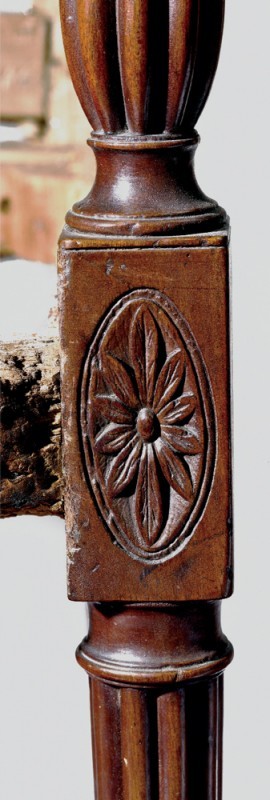
Detail of the carved patera on the right front leg of the sofa illustrated in fig. 76. (Photo, Gavin Ashworth.)

Detail of the carved central panel in the crest of the sofa illustrated in fig. 76. (Photo, Gavin Ashworth.)

Detail of the carved side panel in the crest of the sofa illustrated in fig. 76. (Photo, Gavin Ashworth.)
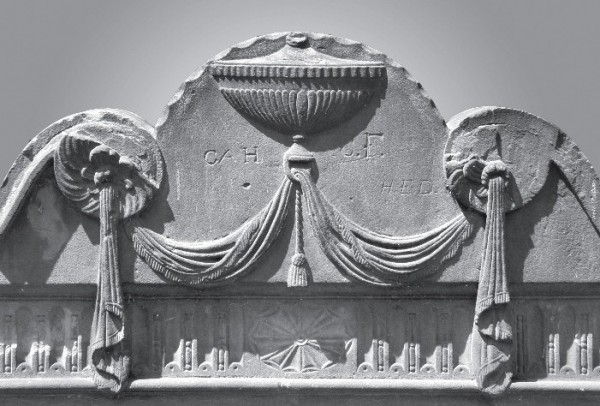
Detail of the double drapery carved on the Eleanor Wren tombstone illustrated in fig. 41.
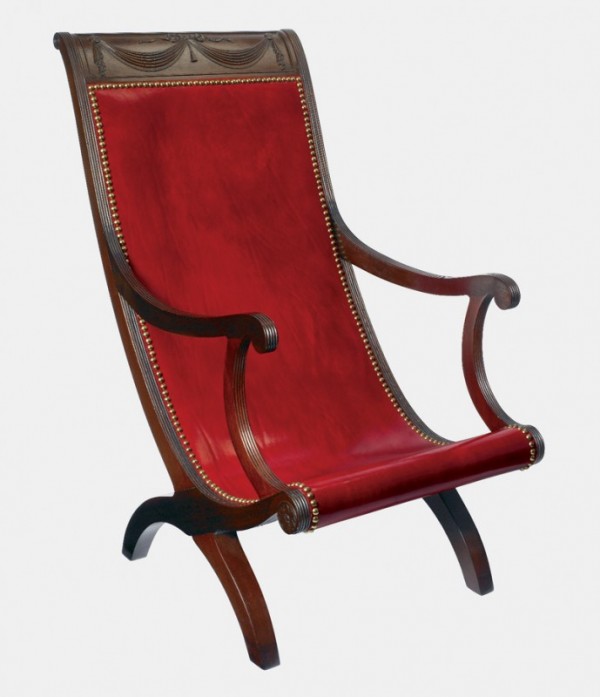
Campeachy chair attributed to William Worthington, Washington, D.C., 1815–1820. Mahogany with tulip popular and yellow pine. H. 37 1/2", W. 21", D. 31 1/2". (Courtesy, Peter Patout; photo, Ellen McDermott, New York.)

Detail of the carved crest rail on the chair illustrated in fig. 81.
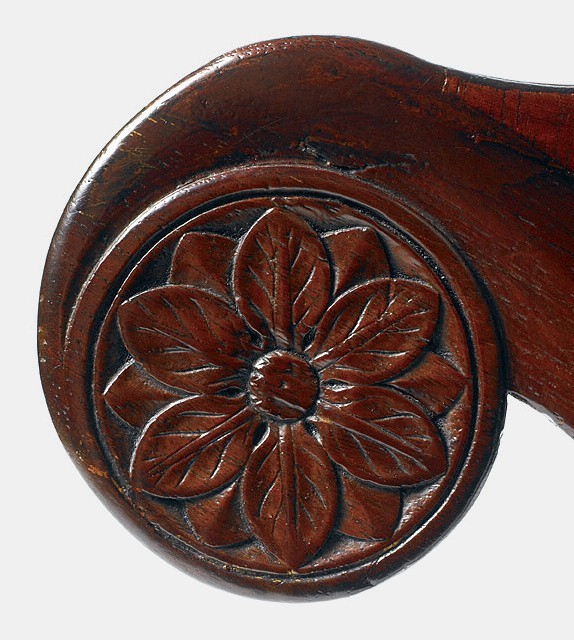
Detail of the carved rosette on the chair illustrated in fig. 81.
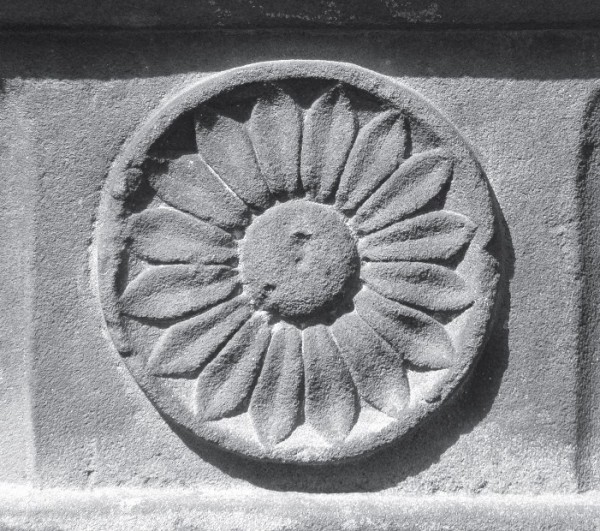
Detail of a rosette on Sarah Wren’s tombstone illustrated in fig. 40.
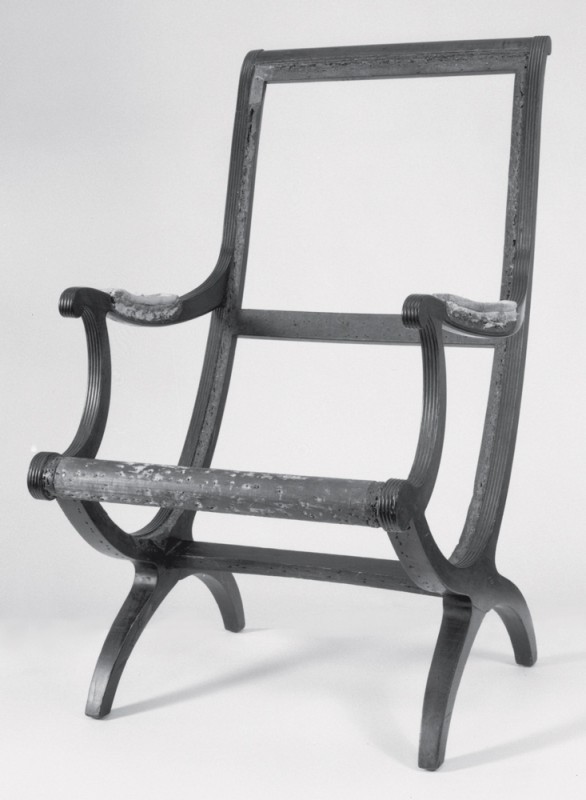
Campeachy chair attributed to William Worthington, Washington, D.C., 1810–1820. Mahogany with yellow pine. H. 40 1/2", W. 21 5/8", D. 29 1/2". (Courtesy, Winterthur Museum; photo, Laszlo Bodo.) Worthington's Campeachy chairs have a bowed brace that is either dovetailed or mortised into the inner edges of the back frame.
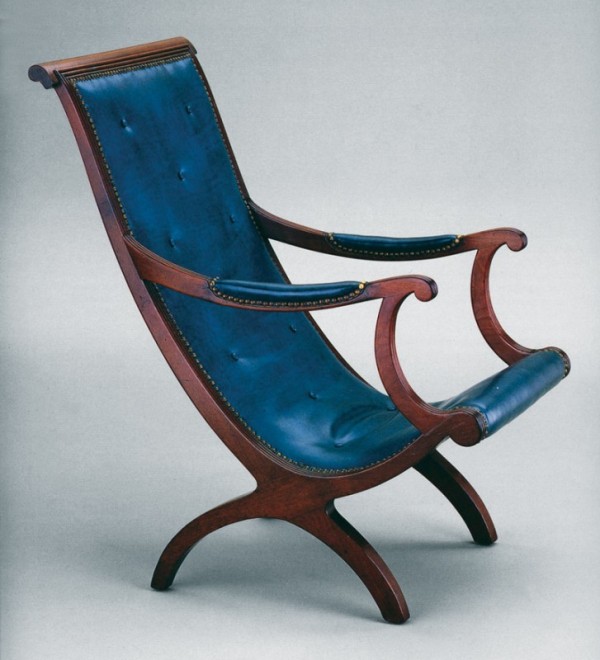
Campeachy chair attributed to William Worthington, Washington, D.C., 1810–1820. Mahogany with yellow pine. H. 38 1/2", W. 24", D. 33 1/8". (Courtesy, Collection of Mrs. George M. Kaufman.)
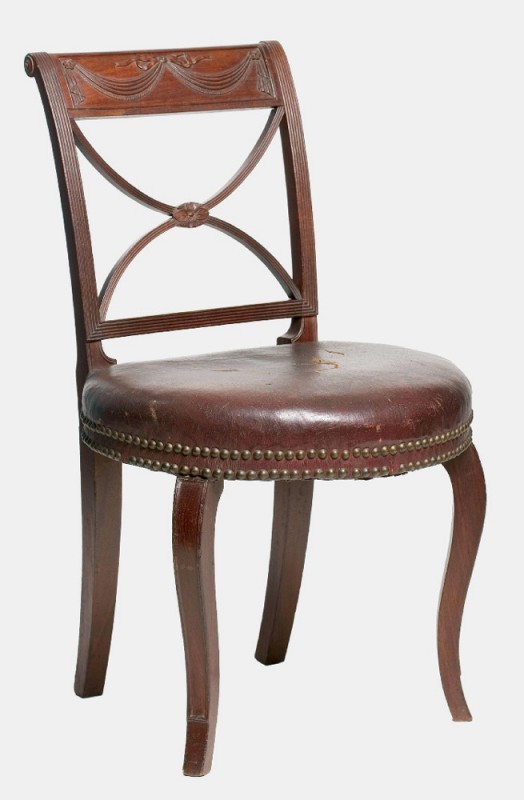
Side chair, possibly Benjamin Belt or Gustavus Beall, Washington, D.C., 1814–1817. Mahogany with mahogany and white pine. H. 33", W. 19", D. 21 1/2". (Courtesy, New Hampshire Historical Society.)
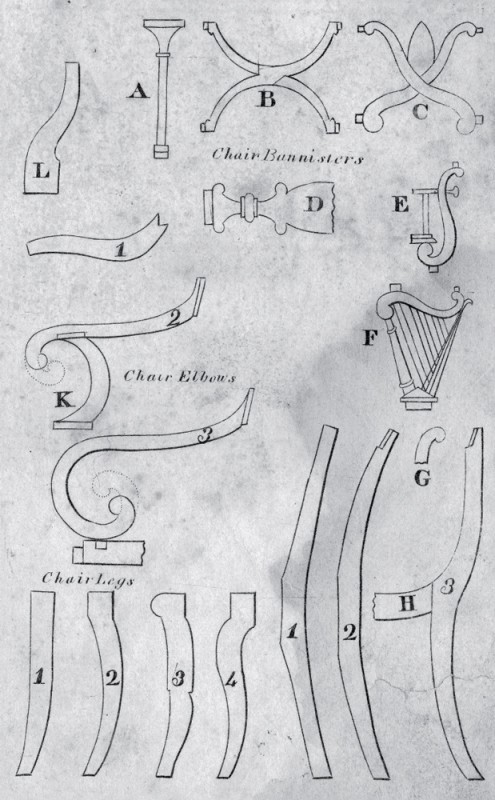
Designs for chair components on pl. 6 in New York Society of Cabinet Makers, The New York Book of Prices for Manufacturing Cabinet and Chair Work, 1816. (Courtesy, Museum of Early Southern Decorative Arts.)
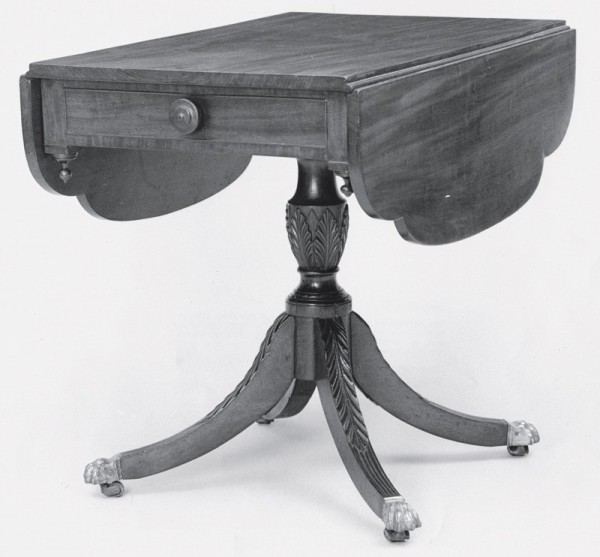
Gustavus Beall, table, Georgetown, D.C., ca. 1815. Mahogany and mahogany veneer with oak and white pine. H. 28 1/2", W. 42 3/8" (open), D. 31 3/4". (Courtesy, Museum of Early Southern Decorative Arts.)
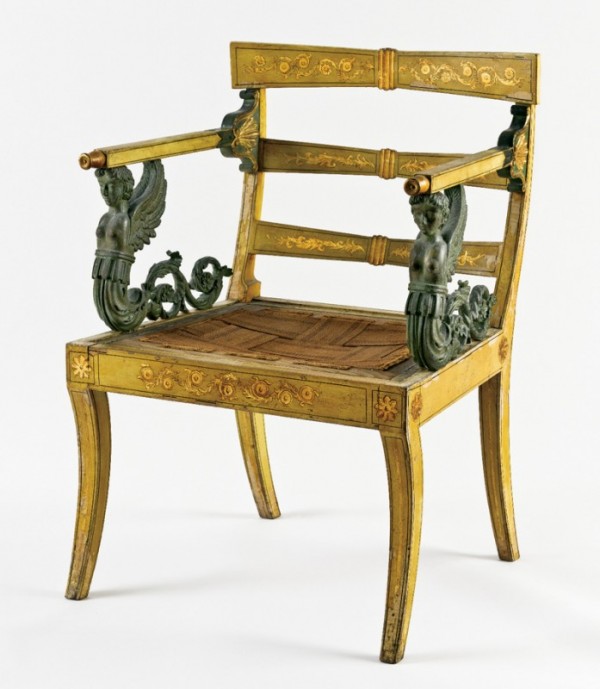
Armchair, probably Washington, D.C., 1815–1820. Maple and ash. H. 33 1/16", W. 23 5/8", D. 18". (Courtesy, James Monroe Museum and Memorial Library; photo, Gavin Ashworth.) Maple was favored for American painted chairs in the 1810–1840 period. Unlike most European antique maple furniture from Europe, the Monroe chairs are not riddled with insect damage.
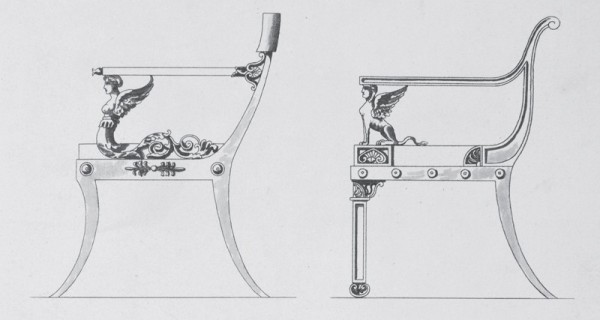
Designs for “Drawing Room Chairs in Profile” illustrated on pl. 55 of George Smith’s Designs for Household Furniture (1808). (Courtesy, Winterthur Museum.)
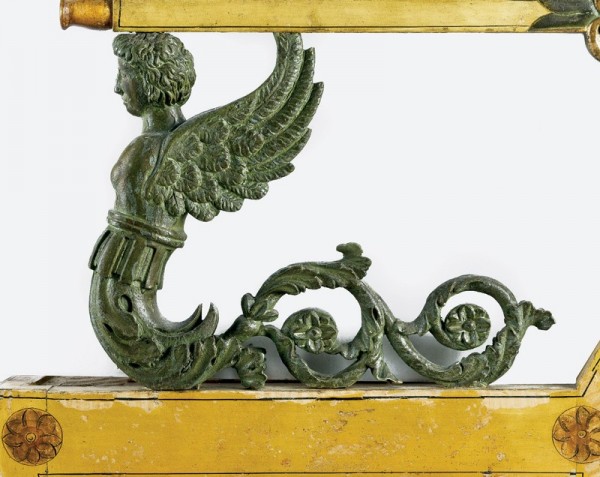
Detail of a caryatid on the armchair illustrated in fig. 90. (Photo, Gavin Ashworth.)
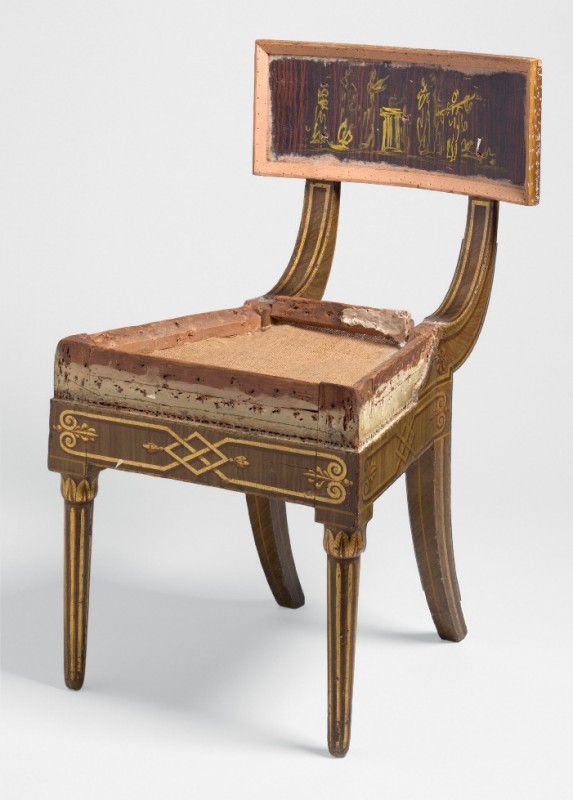
"Klismos" Chair, American, Philadelphia, Pennsylvania; decorator: John P. Fondé 1820-1825. Ash, pine, gilt, wool upholstery, brass. H. 31 3/4", W. 18", D. 22". (Courtesy, The Baltimore Museum of Art: purchased in Honor of James Archer Abbott, Curator of Decorative Arts, 1997-2004, by the Friends of the American Wing, and with additional funds contributed by Frederica K. and William Saxon, Jr., Ruth Ann Adams, Mr. and Mrs. Robert Bentley Adams, Dr. and Mrs. Aristides C. Alevizatos, Mark B. Letzer, Hugh and Joy McCormick, Charles and Mary Meyer, David A. Mozes, Dr. and Mrs. Thomas R. O'Rourk, and Bodil Ottesen, BMA 2003-122; photo, Mitro Hood.)
